cold war spanish navy – Armada 1947-1990 (and modern spanish navy)
 The Armada 1947-1990, About 160 ships.
The Armada 1947-1990, About 160 ships.
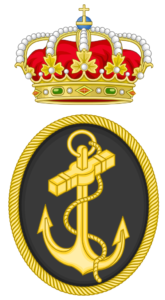 The Spanish Armada under Franco was very much the same as in 1939 and was closely linked to the economical and political context. A modest programme was visited in 1944, but a more ambitious one was possible in 1953 after signing with the US the 10-years MDAP treaty. Despite of this, Spain only became part of NATO in 1982 as a 16th member, and only gradually, with full membership in 1992. The Principe de Asturias became the most visible flagship of the Armada at that time (she was launched in 1982) while in the 2000s Navantia gained traction by exporting its Juan Carlos I LHD (Australia and Turkey) and the Álvaro de Bazán class is today an AEGIS destroyer masqueraded as a frigate. These forces constitutes for Spain a blue water navy, covering for NATO the southern Atlantic sector.
The Spanish Armada under Franco was very much the same as in 1939 and was closely linked to the economical and political context. A modest programme was visited in 1944, but a more ambitious one was possible in 1953 after signing with the US the 10-years MDAP treaty. Despite of this, Spain only became part of NATO in 1982 as a 16th member, and only gradually, with full membership in 1992. The Principe de Asturias became the most visible flagship of the Armada at that time (she was launched in 1982) while in the 2000s Navantia gained traction by exporting its Juan Carlos I LHD (Australia and Turkey) and the Álvaro de Bazán class is today an AEGIS destroyer masqueraded as a frigate. These forces constitutes for Spain a blue water navy, covering for NATO the southern Atlantic sector.

Méndez Núñez – Author’s HD reconstruction. This one a good idea of the obsolescent state of the Navy in the 1950s-60s.
Articles List
- Dédalo aircraft carrier (1967)
- Principe de Asturias (1982)
- Alava class DDs (1946)
- Audaz class DDs (1955)
- Oquendo class DDs (1956)
- Roger de Lauria class (1967)
- Baleares class FFs (1971)
- Descubierta class FFs (1978)
- Numancia class FFs (1987)
- Pizarro class gunboats (1944)
- Artevida class Cvs (1952)
- Serviola class Cvs (1990)
- Spanish cold-war submarines
- Spanish FACs
- Spanish Minesweepers
Franco’s Navy in 1947
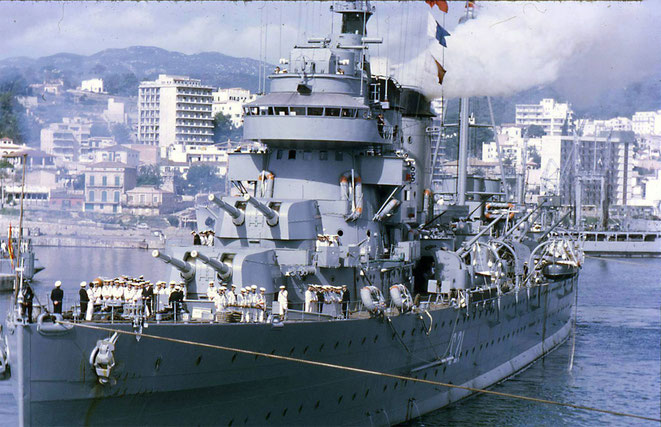
Canarias in the 1960s – shipspotting.net
Spain in the early cold war: From outcast to ally
Before going into more details, let’s cover the situation of Spain when the cold war started: The Armada at that time was pretty much the same as of 1939, but in between, the civil war had left big scars to the country, with more than 500,000 lives lost and many more forced to exile, many to escape political repression or even executions. To add to the material destructions, WW2 completed the demolition of the trade fleet, and left a country impoverished, excluded from any postwar help. A costly isolation out of the UN, and for the US the sole consolation Spain was staunchly anti-communist and should be considered an ally. Negotiations in that sense went on, despite the ambiguous position of Spain in WW2: Sending the Azul Division on the eastern Front breeching its neutrality, and Stalin’s insistence to invade Spain in 1945, rejected by Churchill and Truman.
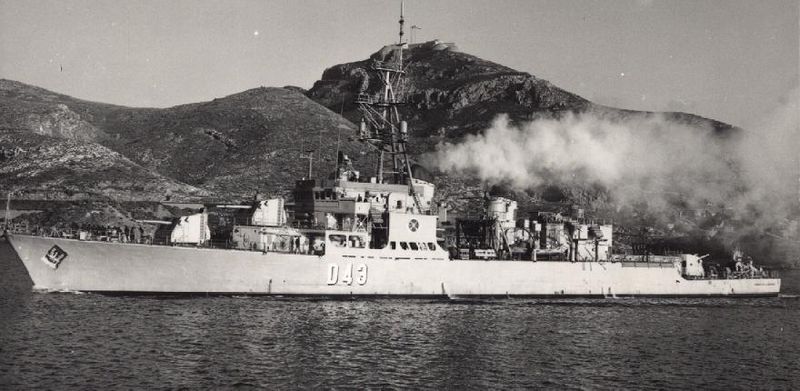
Marques de la Ensenada in the 1960s. These three Oquendo class early Spanish destroyers were plagued with many conception problems and rebuilt. Later the Armada swapped for proven USN Frigate designs
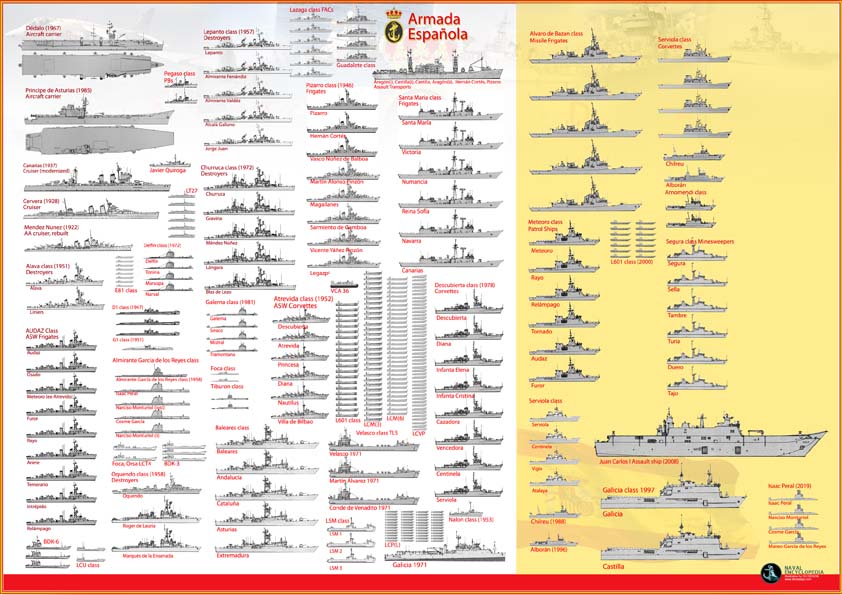
Spanish Armada in the cold war, and today, all the ships.
Later, Stalin vetoed any attempt to integrate Spain to the UN until his death in 1953. At the Potsdam conference it was firmly declared to isolate Spain diplomatically and economically, perhaps hoping for a dramatic change inside the country. The “Spanish question” was one of the early and though challenge of the fledging United Nations, and both USSR and Poland pushed for a UN-backed military intervention. Of course, the US wanted to avoid a communist takeover of Spain, as already strong results of the communists in France’s first postwar elections threatened too the whole balance of influence in western Europe. France advocated to severe diplomatic relationships with Spain instead of an intervention. UN Resolution 39 (Dec. 1946) validated this. The only six countries which opposed it were in Latin America, including Argentina, it’s biggest supporter in the UN. Some countries left their ambassador in place, like Portugal, which had obvious trade relations with Spain. Franco; aware of his lack of legitimacy, drafted a referendum in 1947, putting in the same basket the return of the monarchy and securing his position for life. It was understood that the Monarch would elect a new government in the case Franco died or resigned, which happened in 1975 (see later).
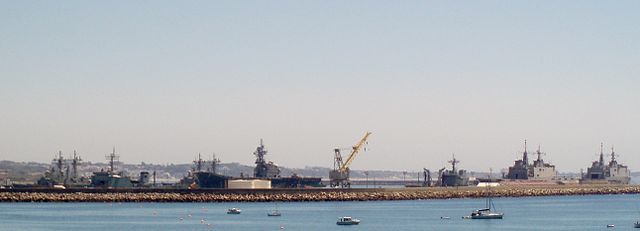
Rota naval base, in Andalucia, on the southern Atlantic coast. Upgraded massively from 1953 and now covering more than 6,000 acres (24 km2), on the northern shore of Cadiz. Already a strategic post for centuries and Spanish naval base, it was radically upgraded and upsized to host USN task forces and an air base for heavy duty planes, such in the 1960s KC-130 stratotankers, B-52s and C5 Galaxy among others. Chief of Naval Operations deployed Submarine Squadron 16 (SUBRON 16) to Rota on 28 January 1964 with USS Proteus while USS Lafayette completed its first Fleet Ballistic Missile deterrent patrol, refit and replenishment from Rota. Ats its peak size (early 1980s) NAVSTA Rota comprised 16,000 sailors, naval personal and their families, and was home to two permanently forward deployed aviation squadrons, VQ2 and Fleet Logistics Support Squadron 22. A patrol squadron of P-3 Orion operated there and between Lajes Air Base in the Azores, to track Soviet naval vessels and submarines. It declined in the coldwar despite a use in 1990’s gulf war, and in 2011, US Secretary of Defense Panetta announced four Aegis warships would be stationed at Rota to bolster the missile defense of NATO as part of EPAA.
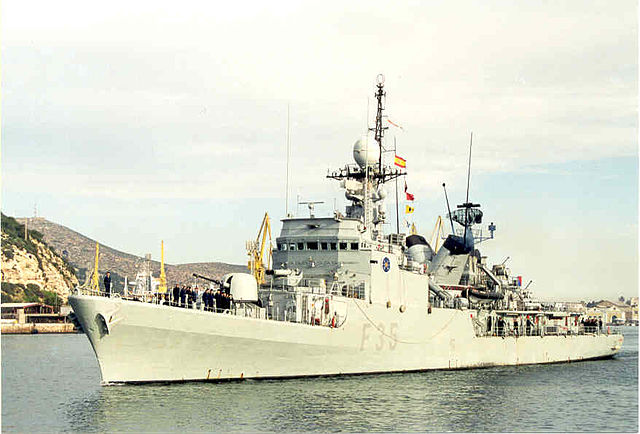
Cazadora (F35) and pan-European Spanish-built ASW Frigate
In between, Spain went on trading massively with Argentina and the USA; The latter went on selling food and oil, while the country tried to established stronger relation to other countries in South America and the middle east. Spain recoignised the arab league in 1946 and pushed its support of Jordan in its war against Israel. In 1949, in recoignition, King Abdullah of Jordan would be the world’s first head ot state to visit Spain. The 1947 Truman doctrine logic natually enticed the restoration of relationships with Spain. In 1950 was voted a massive aid of 62.5 million dollars in aid through US banks. Later both the Arab league and Latin american countries obtained the vote of a new UN resolution brining an end of the sanctions inflicted to the regime, the same year, which passed because of its strong backing from the US. From then on, despite Soviet protests, Spain was allowed to join the UN (but yet not as a member) and its agencies while diplomatic relationships were restored. In 1953 was signed the Concordat with the Vatican whereas Spain joined other organizations, the pact of madrid with massive military aid from the US (which also included MDAP and construction of military bases in Spain, notably at Rota NB, Morón AB, Torrejón AB, and Zaragosa AB), and the death of Stalin ultimately allowed to envision full membership with UN, which was secured in 1955.
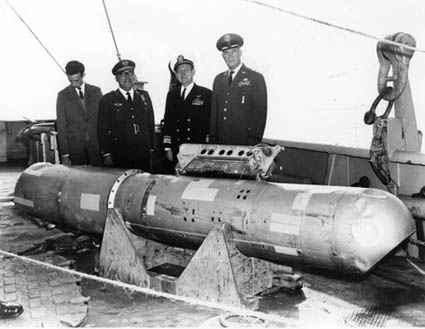
In 1966, a B-52 from Morón AB crashed in Palomares, releasing four nuclear bombs in the area. They detonated upon impact, but not trigerring the nuclear reaction, although one resulting in the contamination of a 0.77-square-mile (2 km2) area by plutonium. Another fell in the Mediterranean. This was perhaps the price to pay for Spain to be “part of the club” again.
The start of the cold war and altitude towards the communist block (which supported and recognised the now defunct republic), allowed Madrid to play its only card: Rapprochement with the West, despite being until then ostracised by nearby democracies. To give some clues of a future change of regime, Franco started to relax and slightly release its grip on power, discarding the Falange, implementing a set of reforms with a law on personal freedom, and promising more importantly a return to the Constitutional Monarchy. However the economical situation was definitively not liberalized, still under the strict control of the state, and stagnant, until reforms were passed allowing the return of private investments, followed by international investments, crowned by the US aid act of 1953 (and signature of the MDAP). This was signalled by the installation of four US naval air bases in Spain, Franco regaining some respectability on the global sphere. However deep changes were postponed until the Caudillo’s death in 1975, with most of the WW2 Armada.
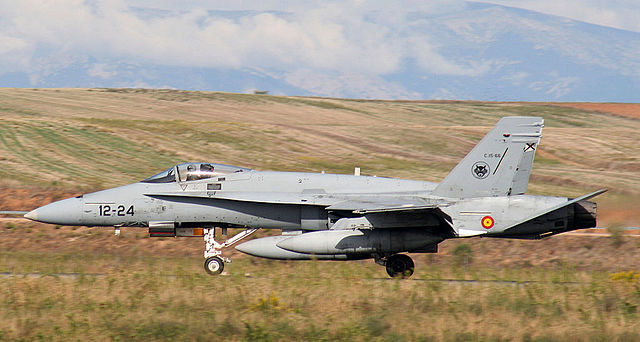
Spanish F-18 Hornet at Torrejón AB, for a long time a major US airbase. These three airbases established in the 1950s took a significant importance when De Gaulle decided to close his country to US military presence in 1966.
In 1947 the Spanish fleet comprised the following:
Cruisers:
-Cruiser (modernized) Navarra (1920), discarded 1956.
-AA Cruiser Méndez Núñez (1922), pennant C 01, modernized as such in 1947, discarded 1963.
-Three Cervera class cruisers (1925-28), pennants C 11-C 13: Galicia, Cervera, Cervantes, partially modernized, discarded 1963-70.
-Canarias, heavy cruiser (1931), partially modernized (radar, AA), pennant C 21 discarded 1975.
Destroyers:
-3 Alsedo class (1922), discarded 1957, no pennant.
-12 Churucca class (1926-33), pennants D 11-41, partially modernized, stricken 1957 to 1970.
-2 Alava class (1946), just completed, pennants D-21 and 23 (see later).
Also discarded in 1949-53 were the two ex-italian large destroyers leaders of the Poerio and Aquila classes: Huesca, Teruel (1914), and Ceuta, Mellila (1919).
Gunboats and Minelayers
-3 Castillo class ships, and Calvo Sotello (1922, 1934) discarded 1953-57, no pennant.
-4 Jupiter class (1935), pennant F 01, 02, 11, 12: Discarded 1970-77.
-2 Eolo class (1939), pennant F21, 22, discarded 1972.
-8 Pizarro class (1944), completed 1946-47, Pennants F 32-42, stricken 1968-82.
Submarines:
-C2 (1928) was discarded in 1952, the two ex-Italian General Mola and Sanjurjo in 1959 and the German G7, ex-U 573, in 1970.
-D class (1944): Completed after the war, D3 was even launched in 1953, discarded 1965-71 after some modernization (streamlining).
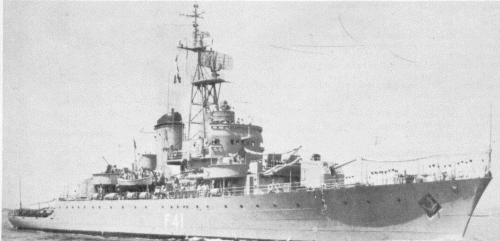
Pizzaro class gunboats
Miscellaneous
To this, we can add the Bidasoa class minesweepers, seven vessels ordered in 1944 and partially completed post-WW2. They were given the pennants M01-06 (but one lost in 1954) and discarded 1971-72. Also were quickly discarded three ex-German S-2 type S-Boats LT11-14, LT-21-26 of the S 73 group, and ex MAS LT-17, stricken between 1947 and 1952. Also many patrol ships, fishery protection vessels, coast guards and custom ships, harbour duty vessels were also discarded in the post-war years.

D3 as completed in the 1950s
1950s completions
The 1944 naval program was calling for a modernization (a reconstruction) of the Mendez Nunez as an AA cruiser,the completion of the fourth group of the Churruca design, authorization of the four Oquendo class, and Audaz class Torpedo Boats, laid down a year later in 1945, despite the type was completely obsolete. From 03/08/1944 were also launched a serie of Pizarro class gunboats, which can be used for a variety of tasks. Also in May 1944 was launched the first of the new three D-class submersibles with a German design. In September, a serie of seven Bidasoa class minesweepers, also based on the German M-Type were launched. They were all completed between 1947 and 1955, but considerably bolstered the fleet after the losses of the civil war. They also formed the bulk of the Armada until Spain started to be opened again “for business”, benefiting from some influx of Western tech and US transfers to modernized the fleet under MDAP. The latter was signed on 1953, and was valid for ten years. This proved invaluable at rejuvenating the Spanish Navy.
Spain and NATO
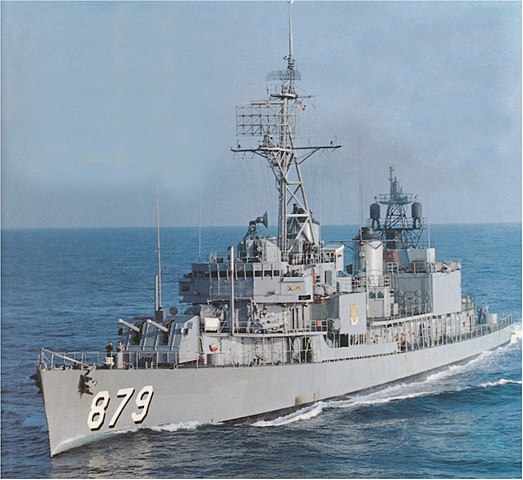
USS Leary (1972), which became later a Spanish destroyer Langara in 1978
Spain was largely seen viewed as a backwards outcast in Europe at the time, of the UN as well, and not only the country was excluded from the Marshall plan, to the detriment of its economy, but Spain only started a rapprochement with NATO from 1986, before being accepted as a full member in 1992, so after the cold war. Despite of this, scenarios of a third world war included at some point or another Spain, and the US could not ignore this. But in ten years, Spain made the transition from an international paria to a recoignised UN member, staunch ally of the USA, and key member of the anti-communist alliance.
Spain had a limited Atlantic reach on its north-west corner, and the Bay of Biscaye, but could control access to the Mediterranean via Gibraltar, still a British enclave which could have been taken if needed. Spain stayed neutral during the whole cold war, but it’s political position towards the North Atlantic Organization was rather favourable, as communist elements has been purged from the society and its position towards USSR was easy to guess in case of conflict.
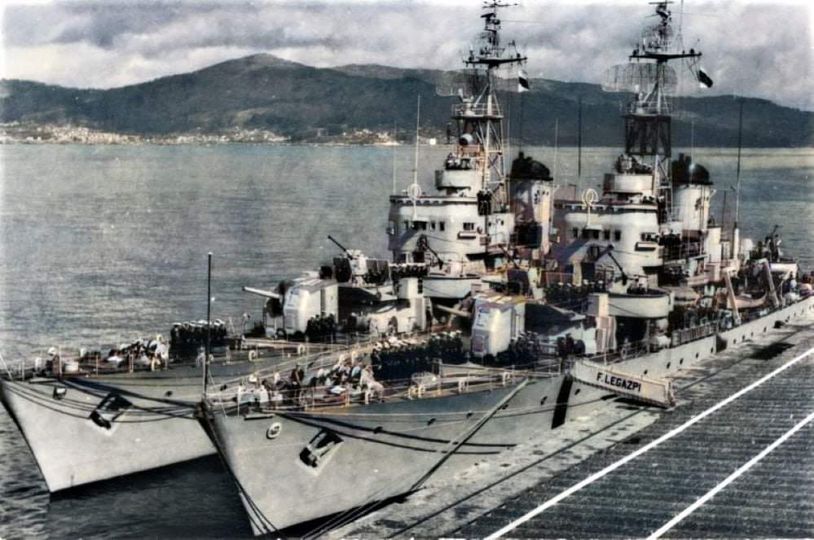
SNS Vicente_Yañez_Pinzon (F-41) and Legazpi (F-42) photographed in the port of Vigo. The Pizarro_class was planned in 1940 and launched in 1944, but completed in 1946-47. These were highy versatile ships, usable as frigates and gunboats. Two units of the class, Vicente Yáñez Pinzón and Legazpi were included in the 1955 Modernization Program. They were rebuilt as ASW frigates still retaining good AA capabilities to be used as esccorts and self-defence, and used US fire direction systems. They operated from Ferrol until the Baleares class frigates came into service.
Vicente Yáñez Pinzón was later used as a schoolship for midshipmen, the other reduced to coastal and colonial patrols. Credits: Unknown, facebook SRC
In case Soviet tanks were unleashed in the plains of Germany, and not stopped (putting aside the use of tactical nukes), would it have been in any interest for Soviet Tanks, after taking out France, to veer south to the Pyrenees ? Crossing the latter was already a thing, and it’s certain there was a strategic interest at securing Gibraltar, but this implied a crossing of the whole peninsula, with rugged terrain not always favourable to tanks. At first, the black sea fleet would have to deal with the Turkish, Greek, Italian and French Navies, in addition to the Royal Navy and a permanent USN Task Force, before even contemplating attacking the Spanish Mediterranean fleet. And the ratio were not very favourable to the Soviets.
By contrast, Portugal was integrated into NATO in 1949. It only had an Atlantic reach, but its membership had always been crucial to establishing air bridges between both sides of the Atlantic. The Portuguese fleet also was vital to guarantee sea-trading lines. The Azores and Madeira formed a strategic triangle with mainland Portugal and the islands would have been od strategic importance for refuelling facilities, track submarines and made surveillance or communication assistance. IBERLANT Command was established in 1967 in Portugal, the southernmost command in the Atlantic, strongly connected to the Allied Command Atlantic (Norfolk, Virginia) at the hinge between Europe and North America, to the Tropic of Cancer, covering 1.150 km seaward from the Strait of Gibraltar, with the task of covering 600.000 square miles of ocean crossed by many shipping routes and sea lanes.
New programmes of the cold war
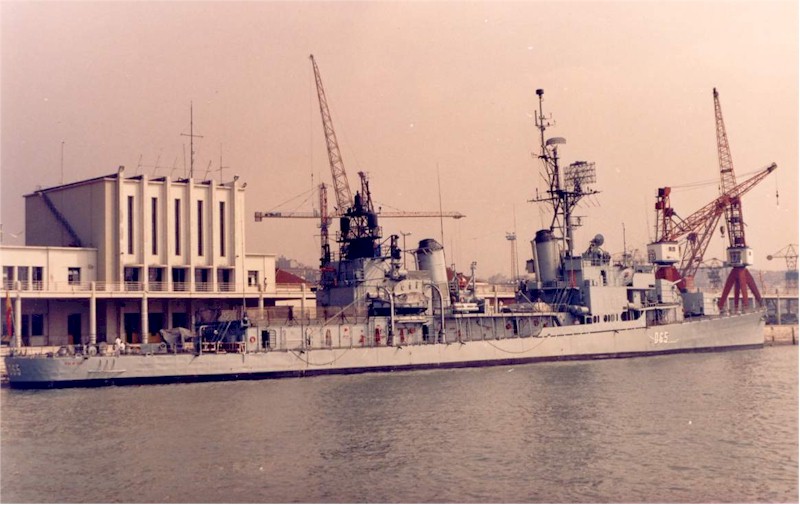
D65 Blas de Lezo circa 1976, Gearing FRAM I type.
1950-60s programmes and MDAP
The signature of the the MDAP between the US and Spain started an unprecedented boom in naval capabilities, bolstered by recent ships, like the Roger de Lauria class, destroyers clearly inspired by the Gearing, of which five, plus five Fletcher-class, entered service in the 1960-70s. Another sizeable transfer was the Aircraft Carrier Dedalo, ex Independence class USS Cabot. Naval estimates doubles between 1954 and 1961, personnel increased from 36,000 to 42,000 while modernization of 30 Spanish ships went on until 1963, with new AA, ASW and electronics concerned the Alava class DDs, Audaz and Pizarro class Frigates, Jupiter class, Atrevida class corvettes, and Almanzora class minesweepers and two D class submarines. The old Churruca class destroyers were even considered for modenrization but this was ruled out for more USN transfers and new construction programmes. Negociations started with the British for the construction of four Leander class frigates, and Oberon class submarines. At that time indeed, Spain was anxious to procure non-American experience and equipments. Radars for the Oquendo class were indeed provided by UK, but tense relationships with the Peninsula and an unfavourable press and parliament killed negociations in 1964.
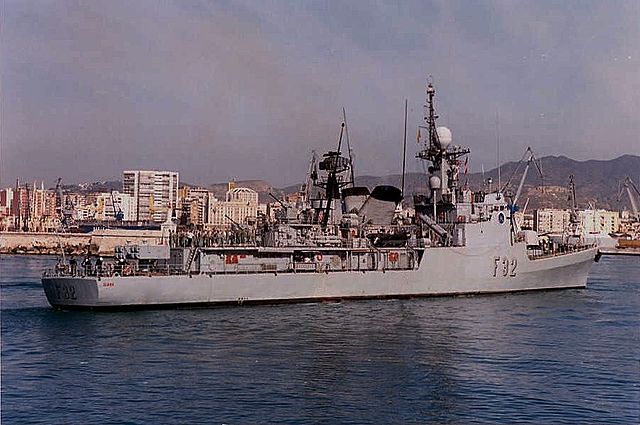
The ASW Frigate Diana (F-32)
Ultimately, ordered went back to the USA, and in alternative to UK, France, notably for its submarines, but many other military materials as well (such as tanks). Agreements were signed in 1966 for licence-construction, which was way cheaper in Spain rather than purchasing ships abroad. This concerned five modified Knox-class and two (+3 in option) Daphne class SSGs. In 1975, the Armada had bold plans, including two aircraft carriers (Dédalo and Asturias), 2 cruisers (modernized Canarias and Galicia or possibly one acquired from the US), eight destroyers, 12 Frigates, 8 submarines, 60 minesweepers, 100 auxiliaries plus 27 ASW patrol planes and 48 ASW/SAR helicopters. This plan was partly realized. The first step in 1967 was the acquisition of the ex-USS Cabot (Dédalo), while plans for another design to be built in Spain were started. To save time and money, a USN design called the US sea control ship type, rejected by the Congress, was chosen. But the program that would be the Principe de Asturias carrier would take ten years to completion and eventually ended as replacing Dédalo instead of making a two carrier force.
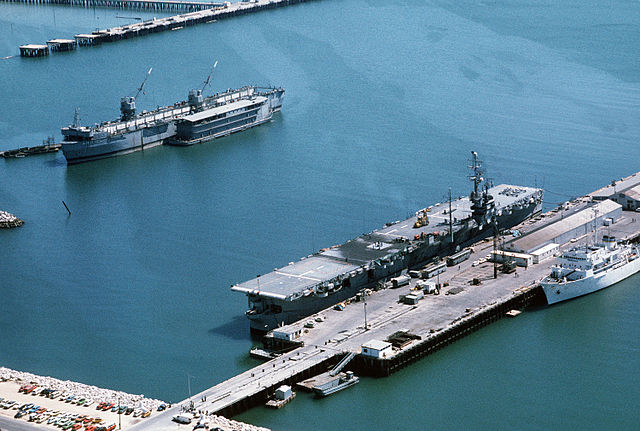
SNS Dedalo at Rota naval base in 1976
From 1973, Dédalo had much increased capabilities with the adoption of AV8-S matador VSTOL aircraft, ordered from the US Marines and delivered in 1976-81. The USN also agreed in August 1970 to transfer two submarines (Balao class), five destroyer (Gearing FRAM), four ocean minesweepers, and four tank landing ships, the last transferred in October 1973. There was another agreement in 1976 for the transfer of four more ocean minesweepers and a repair ship, not carried out. Meanwhile a January 1973 nava plan was annouced, with one light cruiser, three guided missile destroyers, ten corvettes, two subs (agosta class), PF and patrol crafts. Budgetary problems ensured that the light cruiser and guides missile DDs were deferred to 1977, then to 1978 and changed in nature as opportunity made changing the light cruiser to a light aircraft carrier instead while the destroyers became USN FFG 7 Frigates. The Armada’s goal was to have two task forces, one always at sea. Each was centered around a light carrier, one cruiser, four missile frigates, two tripartite minesweepers, tenw corvettes and two subs. This led to the second naval program from 1983 (see later).
Meanwhile, The death of Franco in 1975 changed Spain a great deal. The King of Spain, Juan Carlos I, was prepared to take the succession of Franco, but instead of following the same conservative path chose to open Spain to Democracy. In 1978 Spain ratified a new constitution, and was now a newly free democratic state. The United States had pledged the new government their support, which was limited until then by MDAP to Five ex-Fletcher class destroyers from 1957, and armaments on the Oquendo and De Lauria class destroyers. The tip of the whole program was Spain’s first modern capital ship, laid down in 1979 at Ferrol: The Principe de Asturias a small but capable aircraft carrier, later also adopted by the Thai Navy. At the same time, the fleet comprised Fletcher-class ships and six Perry-class Frigates, a reflection of the long run an strong collaboration of Spanish Naval Yards with US yards.
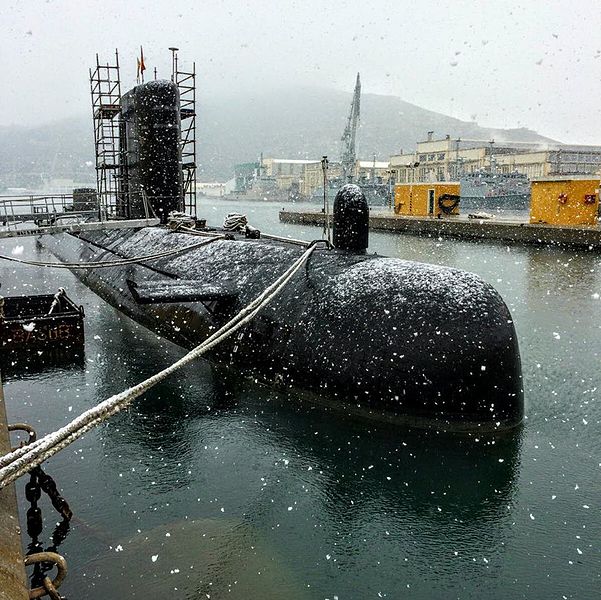
Galerna (S71), an Agosta class under snow
1980s naval plans
The next phase of construction was planned for 1983-1990, basically covering the end of the cold war. Outside the Asturias, two cruisers were still planned, eight more frigates (likely enlarged Descubierta class), two more minesweepers but also 10 Matador VSTOL, six patrol and four ASW planes. Budgetary constrains, again, crippled this to just two destroyers, seven frigates, minehunters and a support ships plus PBs. It was extended FY 1995 to include three subs and two missile DDs of the Spruance class, four FFG-7 and three Type 552/A (Mod. Descubierta), but also six FACs, 13 minehunters, LPD, LSTs, and OSVs. The Spruance class were dropped but instead impressive Álvaro de Bazán class, classed as Frigates but in reality AEGIS missile destroyers were built. Budgetary conditions from 1986 partial integration in NATO urged for military spendings of 2% of GNP, however the Navy took 30% of the total defence budget instead of 20% previously. The 1988-96 plan proposed five NATO NFR 90 AAW Frigates instead of two more subs.
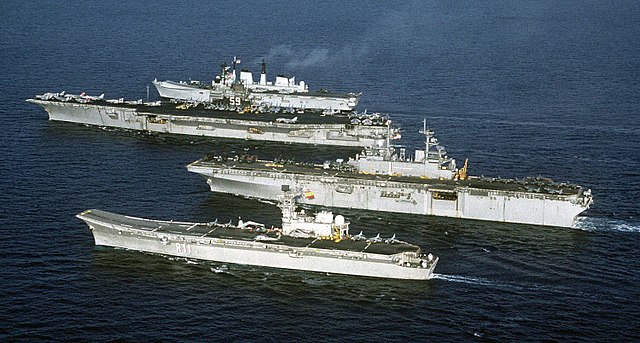
SNS Principe de Asturias, USS Wasp, Forrestal and HMS Invincible during Operation Invincible in 1991
Ultimately in 1989 the last cold war Spanish naval plan was drafted, called the Alta Mar plan (‘High seas’). It was established until 2002 but was recast in 1990 to include replacements for the Gearing FRAM DDs, with four F-100 Frigates (first active in 1998) and five F-110 Frigates to replace the Baleares class. Actually Spain was the last to drop the F90 Frigates project. The plan also planned the modernization of two Agosta-class subs before the new Scorpene class could be started. Most of deliveries were planned for 1994, but the post-war years announced a world economic recession and the Alta Mar Plan was soon in trouble, with cancellations and slips in schedules, notably for the FFG-7 Frigates (OH Perry class), and more crucially, the F 100 Frigates, delayed until the 2000s, while the first Spanish LPD was started by Navantia, and will prove to be quite an export success in the 2000s.
The effort of the Navy did not to enter the bargaining game, with exaggerate dangers or threats and what was achieved was remarkable nevertheless:
-The capacity of the amphibious force was more than doubled, compared to what was planned.
-The capacity of the auxiliary vessels was doubled.
-The displacement and armament of the F-100 was doubled, or even more (They are equivalent, but bettern to the Spruance class once planned).
-The air fleet was increased with moden SH-60s and NH90s.
But above all the acquisition of a second platform multipurpose ship, albeit not a natural aircraft carrier, was enough to replace the Prince of Asturias when in maintenance. Certainly the aforementioned increases still did not raised the Armada to the same level as Great Britain or France but it could be measured against that of Italy or Germany. The chief Admiral in front of the Congressional Defense Commission in 2006 declared that the Spanish Navy whad redeemed the specter of the 1898 war and the poor reputation that followed.
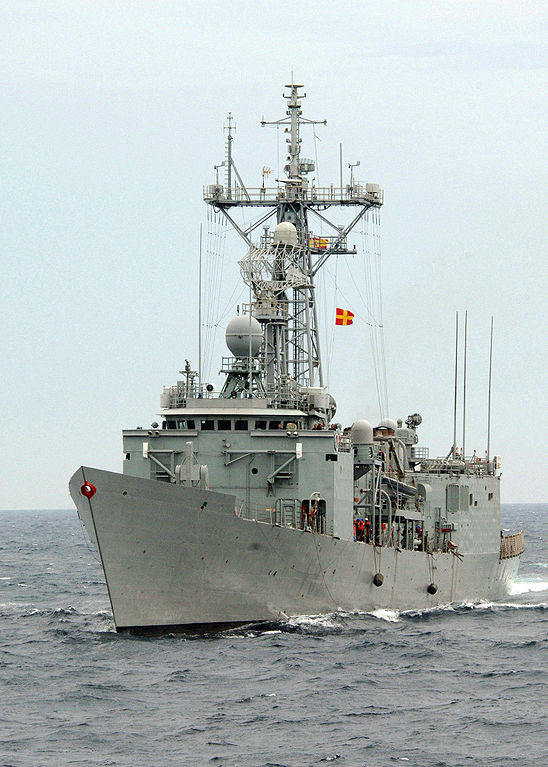
The most ambitious part of the PAM (Alta Mar Plan) was trying to surpass what had been achieved with the Santa Maria class, F-80 frigates (here) and to build even more efficient ships.
The Armada today
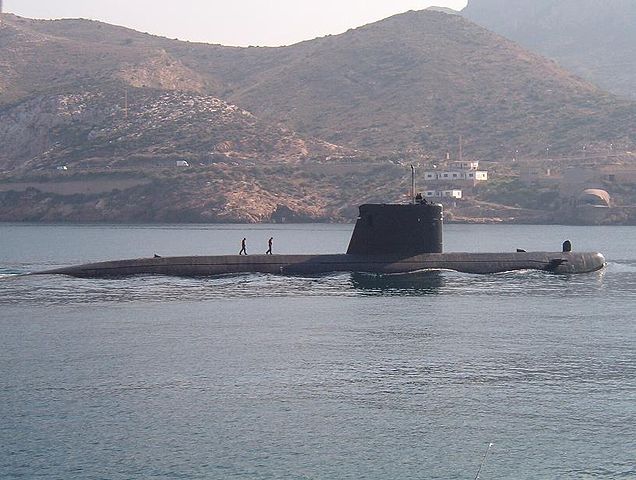
S-73 Mistral underway
Organization
As of 2018, circa 138 vessels were in service in the Armada, including minor auxiliaries. Assault ship & aircraft carriers, missiles frigates, large and small, amphibious transport docks, corvettes, submarines, mine countermeasure vessels, patrol vessels and other auxiliaries goes for a total displacement approximately of 220,000 tonnes. The Navy mirrored the other forces, with a Headquarters called Cuartel general, the main Force (Fuerza) and its Force Support called Apoyo a la fuerza. They are under overall command of Admiral Chief of the General Staff of the Navy (AJEMA).
I-The Navy Headquarters (Admiral Deputy Chief, General Staff (2º AJEMA) is based in Madrid.
It comprised the following:
> General Staff of the Navy, the Office of the Admiral Chief of the General Staff of the Navy, the Department of General Services, Technical Assistance and Signals and Telecommunication Systems, Naval Cultural and Historical Office, Legal Service, Central Internal Audit Service and Central Maritime (Naval) Tribunal.
II-The main Fleet (Fuerza) is headed by the Admiral of the Fleet (ALFLOT) and comprises the following:
> Fleet Command based in the “Almirante Rodríguez Martín-Granizo” Complex, Rota Naval Base
> Naval Action Force (ALNAV), La Graña Naval Station, Ferrol and Naval Action Group, 31st Escort Squadron with the 5 AEGIS Frigates, 41st Escort Squadron (Rota) with the 6 Frigates of the Santa María class, Replenishment ship Patiño, Cantabria and the Naval Action Group 2 1/1 (Rota Naval Base) with LHD Juan Carlos I and two LPD Galicia-class landing platform docks, and Beachmaster Group, with LCM-1E landing craft.
a-Naval Maritime Force (ALMART), Cartagena Naval Arsenal
> Canary Islands Naval Command (ALCANAR), Las Palmas, Gran Canaria Naval Arsenal:
-Canary Patrol Craft Unit, Diving Unit, support units, Naval Commandancy of Santa Cruz de Tenerife and of Las Palmas de Gran Canaria
> Cádiz Naval Action Command, Puntales Naval Station, Cádiz
> Alborán Naval Detachment (of patrol & tow boats), Diving Unit, Naval Commandancy
> Ferrol Naval Action Command with a Naval Detachment, Diving Unit, Naval Commandancy
> Cartagena Naval Action Command: Naval Detachment, Naval Commandancy
> Balearic Islands Naval Sector (Porto Pi Naval Station, Palma de Mallorca): Naval Commandancy of Palma, Mahón, Ibiza
> Mine Counter-Measures Force (Cartagena): MCM command ship Diana, 1st MCM Squadron with 6 Minehunters M-30 Segura class, Diving Unit & Support Force
> Naval Diving Center (Algameca Naval Station, Cartagena)
b-Marine Infantry Force (see below).
c-Submarine Flotilla (FLOSUB), Cartagena
With the Flotilla Command, 3 Submarines S-70 Galerna (Agosta class), 4 AIP submarines (S-80 class), Submarine Base, Training Section and Tactical Submarine Programs Center.
d-Aircraft Flotilla (FLOAN) (Rota Naval Base)
With the Flotilla Command 3,4,6,6,7,9,10,11th Flying Squadrons (Agusta-Bell 212, Cessna Citation, Sikorsky SH-3D Sea King, Hughes 500MD, McDonnell Douglas AV/TAV-8B+ Harrier II, Sikorsky SH-60B/F Seahawk, Boeing Insitu ScanEagle), the Carrier Air Group, Simulation Center, Aircraft Maintenance Center and General Support Units
III-The Support Force:
With the Department of Personnel (AJEPER) in Cádiz, Logistic Support Department (AJAL) also in Cádiz and the directorate of Economic Affairs (DEA) in Madrid.
Spanish Marines:
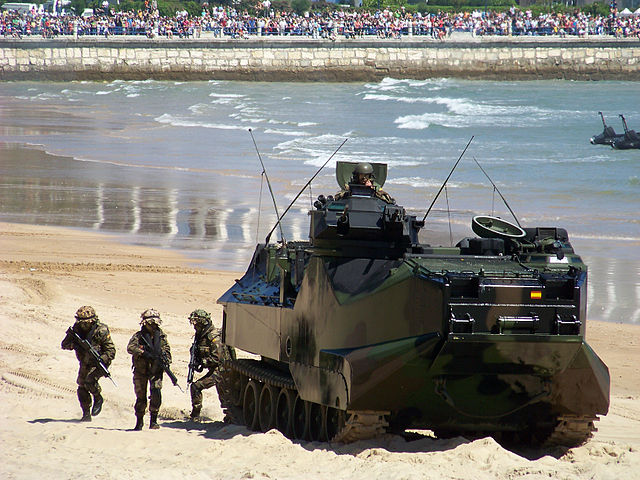
AAV-7 in operations during a display at Santander.
The Marine Corps is probably the most ancient in Europe, going as far back as 1537. One of the most famous of Spanish Marines was without a doubt Miguel de Cervantes, wounded at the climactic battle of Lepanto. Its motto still is “Per Terra et Mare” (“By Land and Sea!”). It was involved, Outside Lepanto and countless small engagements, in the War of Jenkins’ Ear, the Siege of Pensacola, the Spanish–American War, Rif War and Spanish Civil War. It was reformed at first in 1717 as the Cuerpo de Batallones de Marina, while the specialized Real Cuerpo de Artillería de Marina was created in 1833, later abolished in 1857. In 1879 the Academia General Central de Infantería de Marina was founded.
Batallones Expedicionarios were used in several colonial wars. Discredited by the Battle of Gallipoli during WWI where naval assault showed its limits, the Marines deployed in Morocco, despite their success, were soon described by the political left in Spain as a leftover of the Spanish colonial era and planned to be disbanded after the Spanish Republic was created in 1931. However the Civil war erupted before, and the latter partly joined the Nationalists, whereas the garrison of Cartagena, and a detachment in Madrid stayed loyal to the new government.
During the cold war, Francisco Franco increased their strength and the Infantería Marina was increased, while in 1957 the Grupo Especial Anfibio was created as a projection force, soon in action at the Ifni war. It as found in action in Spanish Sahara and got new amphibious vehicles, anti-tank weapons, individual equipment and artillery, as well as many ww2-era surplus landing crafts. However there was still no large dedicated assault ship, but from 1960: LCU and LCM were acquired, in 1964 and 1965, Aragon and Andromeda an Haskell-class Attack Transport and attack cargo (Two more in 1980). From 1971, Four ex-US Dock and Tank landing ships.
The Tercio de Armada (TEAR) became the main amphibious unit was restructured through the E-01 Plan. The latter redefined requirements and structures FY2000 for the Spanish Marine Infantry, with rapid deployment capabilities in Central America and Asia as an “emergency force”. It primary role was to evacuate civilians in conflict areas, or to act combined with other allied forces within NATO. In this frame, these were deployed in Afghanistan. Main base today is San Fernando. As in many other countries, special forces (Fuerza de Guerra Naval Especial) were created. They had operated in Somalia, Haiti and Lebanon.
The Marine Infantry Force id under the Commandant General of Naval Infantry (COMGEIM) a 2/2 stars admiral based at San Fernando, Cádiz.
It comprised the Naval Expeditionary Force Tercio de la Armada (TEAR)
> Naval Infantry Brigade (BIM) 1/1 star, at San Fernando, Cádiz
> Protection Force (Fuerza de Protección) (Marine Infantry Madrid Detachment, Northern Battalion (TERNOR) in Ferrol, Southern Battalion (TERSUR), Rota Naval Base, Eastern Battalion (TERLEV) Cartagena, Security Unit of the Canary Islands Naval Command (USCAN) in Las Palmas and Naval Special Warfare Force (FGNE) Algameca Naval Station, Cartagena.
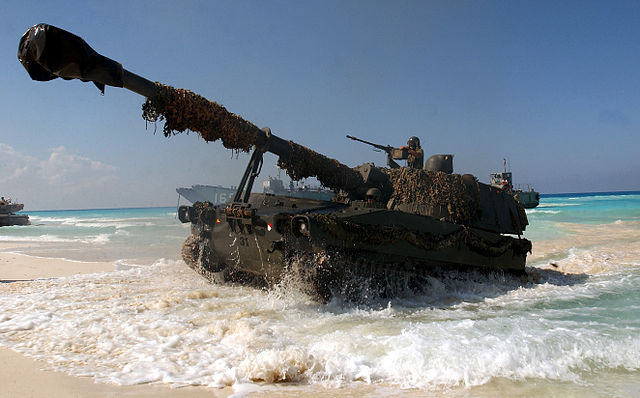
M109A5 landing ashore SPH during the combined operation Bright Star 2001.
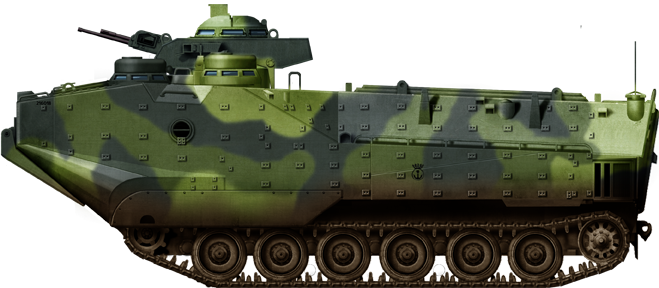
Spanish LVTP-7A1 (AAV-7A1)
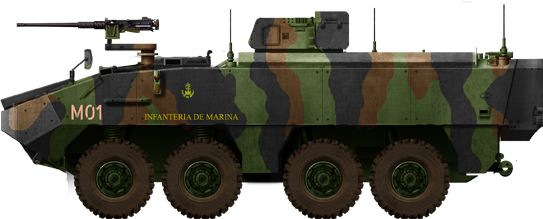
Spanish Armada Piranha III, command version
The largest armoured components today is the 3rd Mechanized Landing Battalion, operating in full strength with one HQ & Service unit, two Mechanized sections equipped with the Piranha IIIC, a Tank unit with the M60A3 Patto and a Weapons Company. Outside the artillery battalion, the other motorized unit is the Amphibious Mobility Group, with an HQ & Service, Engineer sections, one Amphibious Assault Vehicle section reinforced with an Anti-Tank (TOW) unit. In addition to six M109A5, the Spanish Marines operates 17 M-60A3 TTS, 39 Piranha IIIC 8×8 in various versions, 19 AAV-7A and 124 Humvee now almost all replaced by the URO VAMTAC BN3.
Late Cold War Reforms
Technical matters
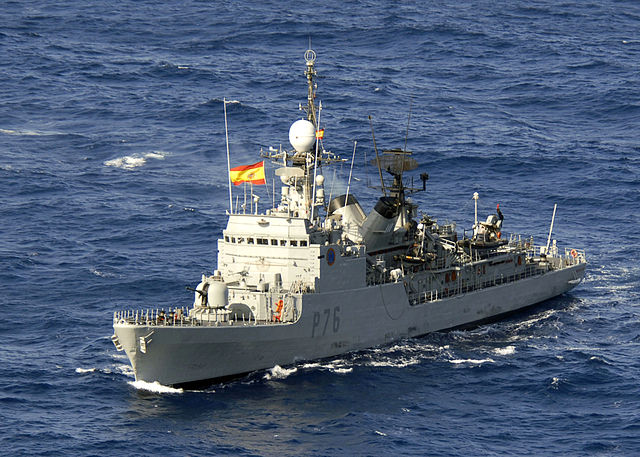
As it appeared, Spain attached a great deal of importance to reach self-sufficiency for ship design and construction. As long as possible, licences were acquired. The process had to advantage to spare a great deal of R&D money and make the finished produced more attractive to the export market. At first, the limited development of local electronics industries and defence industries at large signified the country would purchase most of its hardware abroad. In terms of tanks, apart purchased and upgraded M60 and AMX-30s, only ENASA could provide a truly domestic design, the Pegaso BMR, and later the Pizarro, a join-venture with Austria. In the air, CASA (which started licence-building German planes) provided some decent transport and light aircraft but nothing to the scope of a multirole fighter, although participating in the Typhoon project since the origin.
One example is quite telling about this: The Descubierta class corvettes started with a stretched-out German MEKO design, with German powerplant, Italian and Swedish armament, and Dutch electronics. The Corvettes were quite a success of themselves. More recently anoyher of these example had been the Meroka CIWS using rotating Oerlikon 20 mm barrels and proved quite a potent short-range weapon. Traditionally surface ships and Subs had been built in cartagena, frigates at Ferrol, and small crafts at La Carraca Yard, Cadiz.
Strategy and Operations
Initially the Navy’s main task was to protect what remained of the Spanish colonial empire, but today Spain is not even in the top 20 largest EEZ. The Armada was about also to project traditionally power an prestige, and there had been some actions that mobilized the Armada during the cold war:
-The Ifni war, an enclave attacked by Moroccan irregulars, in five occasions between 1957 and 1965. At some point, the cruisers Canarias, Cerventaes, Nunez with destroyers and supply ships ended in territorial waters of Morocco and in front of the entrance of the port of Agadir.
-There is also the long-standing question of Gibraltar. Standing as a British Bastion since its transfer on 11 April 1713, the “rock” was a point of contention bewteen the two governments since a long time. In 1982 if the British had not sent the fleet and left the Falklands to the Argentines it is likely Spain would have been more willfull to retake Gibraltar by foce if that was not diplomatic skills and the fact the rock was also essentially a large military base, airbase and naval one (and the proximity of Spain to the UK). In 1969-1970 the claims for gibraltar reached boiling point when the freshly acquired aircraft carrier dédalo and escort was sent to the bay of Algeciras, facing Gibraltar. Nevertheless, the carriers Eagle and Hermes had arrived just before and acted as a deterrent.
In the 1980s the whole of the Armada was stationed at Ferrol, to the exception of the Descubierta class in Cartagena. Old FRAM I and submarines were moved to the Mediterranean, but Spain always kept the best and more modern assets in the Atlantic, participating in more and more joint exercises with NATO. Recently the fleet’s doctrine is absed around two scenarios:
-A localized conflict with Islamists taking over nearby Morocco and attacks on Ceuta and Melilla were planned. Threats to the Canarias and fishing fleets were also taken in account.
-A large scale conflict with USSR (or the east after 1990) and according to NATO scenarios, would have cooporeated in the Atlantic for subarine hunting and protect the waters near the Gibraltar strait. In 1987 the main command center was moved to Rota, next to the US naval base.
-In 1990’s gulf war, three Santa Maria class frigates were sent to red sea as part of a multinational policing force.
-In 1994, some Spanish ships under UN mandated participating of a blockade of former Yugoslavia, to stop arms smugglers.
New ships:
In 2018, 138 vessels were in service in the Armada, including small auxiliaries, and comprised amphibious assault ship and transport docks, frigates, submarines, mine warfare vessels, patrol ships and auxiliaries for a grand total displacement of around 220,000 tonnes.
 Alvaro de Bazan class Frigates
Alvaro de Bazan class Frigates
Álvaro de Bazán, Almirante Juan de Borbón, Blas de Lezo, Méndez Núñez, Cristóbal Colón
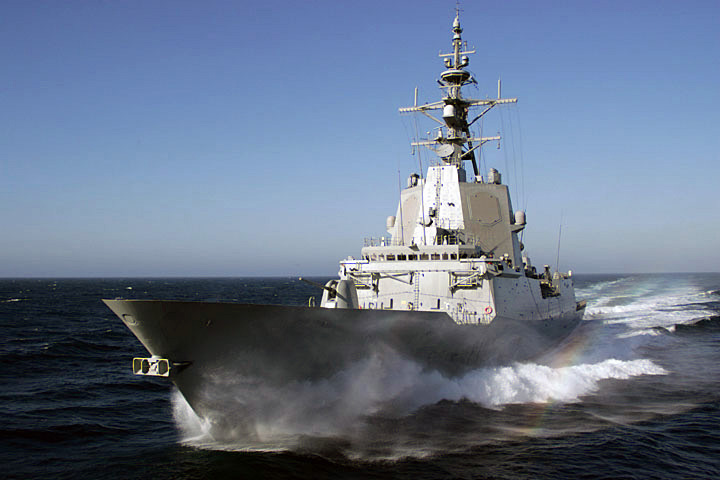
A port bow view of F 100 Class Frigate, ALMIRANTE JUAN DE BORBON (F 102) underway in the Pacific Ocean during Combat Systems Ship Qualifications Trails on the Pacific Missile Test Center Range off the coast of California (CA).
These long-awaited missile destroyers, turned Frigates, were a major milestone in Spanish capabilities. In short, they were the First European Warship With The Aegis Weapon System. This was truly a powerful symbol of the trust and strong military ties wit the US. This class was widely regarded as the most powerful Frigate class in the world at the time. The F100 class were built by Navantia in Ferrol, and in 2018, was naturally selected as one of the five finalists for the U.S. Navy’s FFG(X) program. Their strenght rested around the AN/SPY-1 RADAR, only shared at the time by Japan’s Kongō class, and South Korea’s Sejong the Great class, or more recenntly the Norwegian Fridtjof Nansen class. The design was also the basis for the Australian Hobart-class destroyer.
The Álvaro de Bazán-class incorporated ballistic resistant steel hull, and anti-vibration mounts for the powerplant. They were planned to do the following:
• Medium-size oceanic escort.
• Command and control ship in conflict scenarios, capable of operating with allied fleets, and providing cover to expeditionary forces.
• Capable of operating in coastal and blue waters depending on the conflict situation.
• High anti-air capability.
In addition to the Lookheed-Martin AN/SPY-1, the ship was fitted with:
-Raytheon SPS-67(V)4 surface search radar
-Raytheon DE1160 LF active and passive sonar
-Two ARIES navigation/surface radars
-Two Raytheon SPG-62 Mk99 radar illuminators.
Each of the four vessels (the sixth was cancelled due to budget restraints), were given a powerful armament comprising the following:
-5 in (127.0 mm)/54 Mk45 Mod 2 gun
-CIWS FABA 20mm/120 Meroka system (provision).
-Mark 41 (VLS) (48-cell)
-32 Standard SM-2MR Block IIIA
-64 RIM-162 Evolved Sea Sparrow Missile (4 per cell)
-Eight McDonnell Douglas RGM-84 Harpoon anti-ship missile
-Two twin 12.75 in (323.8 mm) Mark 32 Mod 9 torpedo tubes with 12 Honeywell Mark 46 Mod 5 torpedoes
-Sikorsky SH-60B LAMPS III Seahawk
For active protection they were armed with:
-Four FMC SRBOC Mk36 flare launchers
-SLQ-25A Enhanced Nixie torpedo countermeasures
-Indra SLQ-380 EW suite & Mk 9500 interceptor
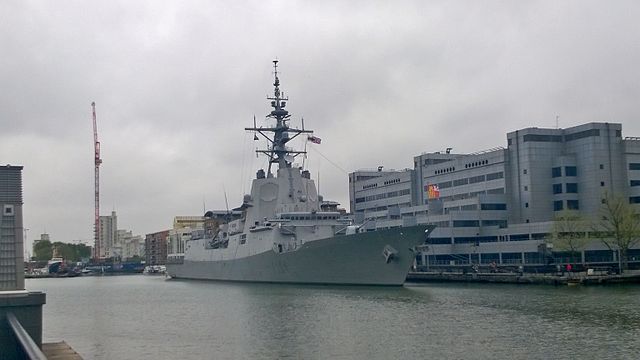
Mendez Nunez in london. Also built by Navantia in Ferrol were the relatively similar F-310 Fridtjof Nansen class (built 2006–11) and Hobart-class destroyer (built 2016–19).
 Juan Carlos I class LPDs
Juan Carlos I class LPDs
Juan Carlos I (Spain), Canberra, Adelaide (Australia), Anadolu, Trakya (Turkey).
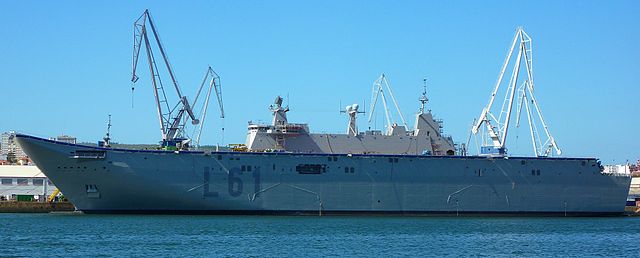
The other major achievement of post-cold war Spanish Naval industry was the LPD Juan carlos, quite a success which conducted Australia to buy the Camberra class based on her in 2008, commissioned in 2014, and the Turkish Navy which ordered the TGC Anadolu with some technology transfer at Sedef Shipyard.
This 26,000 tonnes, 230.82 x 32 x 6.9 m ship was propelled by two 11 MW POD for 21 knots and 9,000 nautical miles range, and carried Four LCM-1E with an overall capacity of 913 soldiers and up to 46 Leopard 2E tanks. Complement of the crew is 261, added to the air wing, 172 strong, this make for a potential 1346 personal on board.
Sensors and processing systems used the LANZA-N air search, ARIES surface search, PAR aircraft landing, EID ICCS integrated communications control system, REGULUS and RIGEL active protection systems, and armament: Four 20 mm guns, two BPDMS and a VLS (FBNW) and four 12.7 mm machine guns with an air group comprising 25 AV-8B Harrier II(or F-35B), with 6 spots for Chinook, Sea King, and NH-90 helicopters. The ideal hangar capacity combination was 11 AV-8B + 12 NH90 + 6 more on the flight deck parking spots.
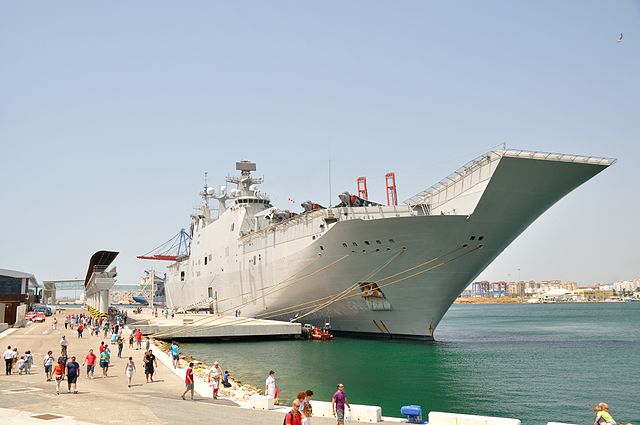
LHD Juan Carlos I in Malaga
Spanish Fleet air Arm:
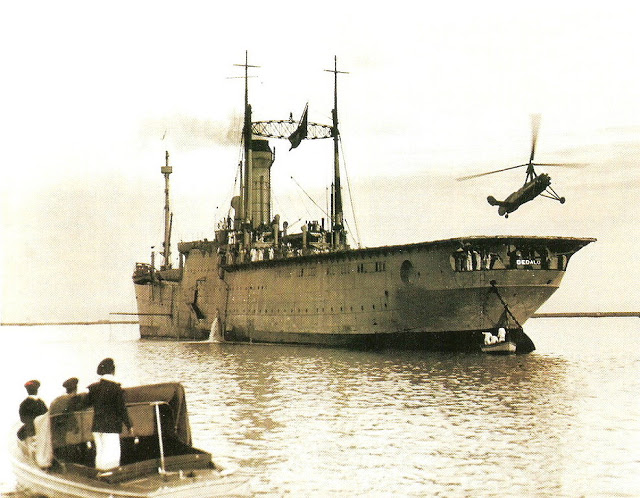
Though the initial 1928 Dédalo (“Daedalus”) was the first Iberian “aircraft carrier”, using Autogyros, the new ship of the same name (R03) in service in 1967 enabled true modern carrier-borne operations to the Armada. The latter carried VTOLs because of size constraints. The choice of a particular plane, the Harrier, was not random: In 1982 the Falkands war pitted Sea Harriers, naval version of the Hawker Siddeley Harrier first flew 28 December 1967 and was introduced with the RAF in 1969. It was a very unique plane on the world stage due to its VSTOL capabilities, offering a relatively small carrier the possibility of using supersonic jets. This served the Royal Navy well, with its medium size WW2 era carriers, and could serve other countries with modest size carriers as well, but also the Unites States: The US Marines found appropriate to have them onboard assault ships as the AV-8 and later the Harrier II.
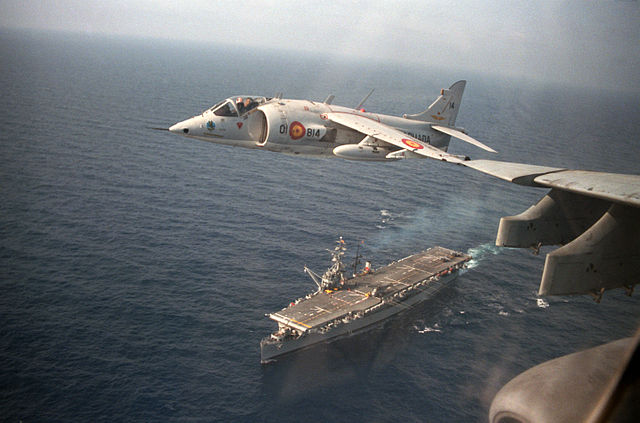
AV-8S Matador above SNS Dédalo in the early 1990s
The navies of Spain and later Thailand bought the Harrier for use as their main carrier-based fixed-wing aircraft. However for Spain this purchase was complicated by long-standing political friction with the British government. Eventually the US Version was purchased, the latter being used as an intermediary, while it was manufactured in the UK. Tests started in November 1972, British pilot John Farley operating onboard the wooden deck of SNS Dédalo. In 1976, the Spanish Navy operated the specifically designed AV-8S Matador. Later later five more were purchased directly from the British government to replace losses in operations. Outside Spain, Australia, Brazil, Switzerland, and Japan were approached but only India purchased the Sea Harrier. Spain later would sold seven single-seat and two twin-seat Harriers to Thailand in 1998 to serve on the HTMS Chakri Naruebet and swapped to the Harrier II.
-13 McDonnell Douglas AV-8B Harrier II (since 1987) + 4 Cessna Citation
-Helicopters: 7 Agusta-Bell AB 212, 5 Hughes 500M, 10 Sikorsky SH-3 Sea King*, 18 Sikorsky SH-60 Seahawk.
In addition, 7 NHI NH90 are on order (2021-22)
Future of the Armada
Future ships:
-F-110 class (5-6 planned, 2021-2025)
-S-80 class submarines (Current, 2007–2021)
-Meteoro class patrol & auxiliary vessels (3 planned)
Read More/Src
J. gardiner Conway’s all the world fightning ships 1922-1946 & 1947-1995
hazegray.org
Plan_ALTAMAR
Active Spanish vessels
On armada.defensa.gob.es
On revistanaval.com
List of retired vessels
Spanish Naval Air Force history
Nomenclature
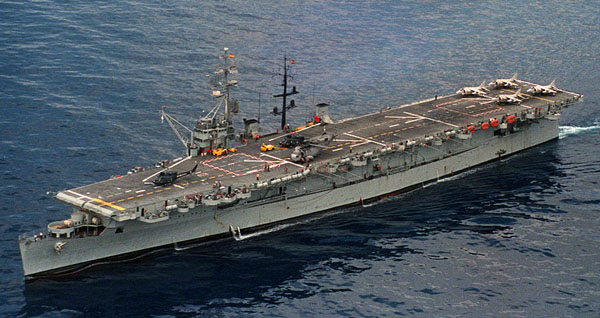
Cabot was a USS Independence class light aircraft carrier, launched in April 1943 and completed in July, deactivated in 1947 and mothballed, recommissioned in 27 October 1948 and decommissioned again in 21 January 1955. Decomm. reserve until 1967, loaned to the Spanish Army under MDAP. In 1973 she was purchased outright by the Armada. The USN completely modernized her before transfer. She had strengthened decks and lifts to carry jets, new electronic equipments and modernized electrical network. Two funnels were removed and hangar capacity was established to 20 aircraft, speed 24 knots. In the 1980s the Armada thought to modernize her with US assistance in order to keep her in service with Meroka CIWS and be used in parallel to the Prince de Asturias. She was returned in 1989 to the US and is now on display as a museum ship in New Orleans.
Specifications
Displacement, Dimensions, Machinery, Armour: As Independence class.
Armament: 2 quad, 9 twin 40 mm, 7 VSTOL aircraft (Harrier 2), 20 helicopters.
Sensors: Radar SPS-6, SPS-8, SPS-10, SPS-40, mk28/29, Tacan.
Crew: 1112 less aircrew
 Aircraft carrier Principe de Asturias (1982)
Aircraft carrier Principe de Asturias (1982)
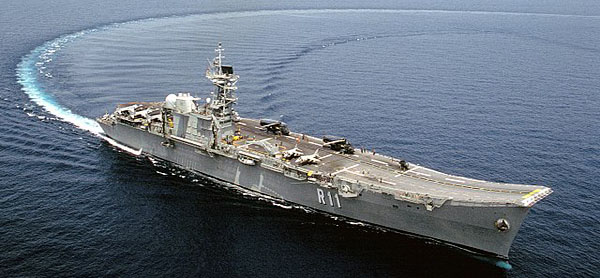
This aircraft carrier was approved in 1977 and a tender was proposed for the design (won by Gibbs & Cox), construction was entrusted to Ferrol NyD, and started in October 1979, launched in May 1982 and completed in May 1988. Gibbs & Cox from New York proposed the updated control ship, a type proposed for the US Navy FY 75 but never funded by the Congress, and fitted with a 12 degree ski jump to deliver the planned Harriers, also included in the contract. The final VTOL chosen were the EAV-8B Matador, 17 were to be operated, when delivered from 1987.
The flight deck measured 575 x 95 feets (175.3 x 29 m) with two lifts, right aft and forward of the island, the other offset to starboard. Nominal complement of 17 planes could be in theory pushed to 37 VSTOL aircraft and helicopters. Max operational at once was 24 and Normal operational was 20. Completion was delayed by the installation of a lower bridge and consequent modifications of command and control systems to be used as fleet flagship. In 1990 there was a refit, as the flight control position was enlarged and extended, accommodations increased to 55 more personal. As in the FFG-7 class, two small retractable electric motors in propeller pods provided and emergency steering and propelling solution.
Specifications
Displacement: 16,700 tonnes FL
Dimensions: 195.9 x 24.3 x 9.4 (642 x 79 x 30 feets)
Machinery: 1 shafts 2 LM 500 Gas turbines, 46,400 shp, 26 knots, range 6500nm/20kts
Armament: 4×20 mm CIWS meroka, 2 saluting guns, 17 VSTOL aircraft (Matador)/helicopters.
Sensors: Radar SPN-35A, SPS-52C, SPS-55, Tacan.
Crew: 763 less aircrew
 Liniers class (Churruca III, 1950)
Liniers class (Churruca III, 1950)
D-51 Liniers (1951, modernized 1962* BU 1982), D-52 Álava (1951, modernized 1962, BU 1978)
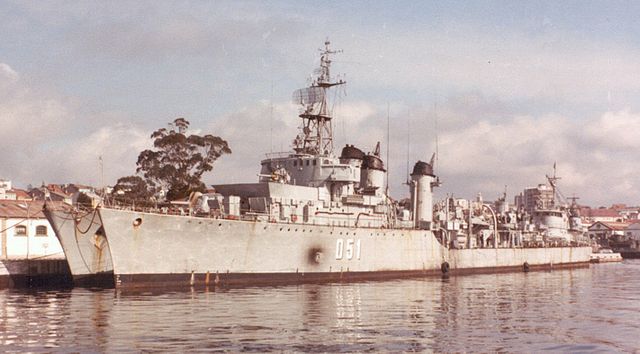
The last of the Churruca serie, largest destroyer class in the Spanish Navy, started in 1924 ended with the “third group” laid down in 1936 but virtually suspended for the duration of the civil war and resumed after design modification at the end of WW2. They were officially laid down again in December 1944 and January 1945, and launched in May 1946 (Liniers) and June 1947 (Alava), completed in January 1951 and December 1950 respectively, so fifteen years after they were first laid down. They had basically the same arrangement of the previous group less the admidhip 120 mm guns, replaced by some AA and two quadruple TTs instead of triple. Also, they received three twin 37 mm, at completion, four more than planned initially, and three single 20 mm AA. Of course this configuration was soon obsolete and by 1961-62 they were taken in hands to be rebuilt and modernized, reclassed as ASW Frigates.
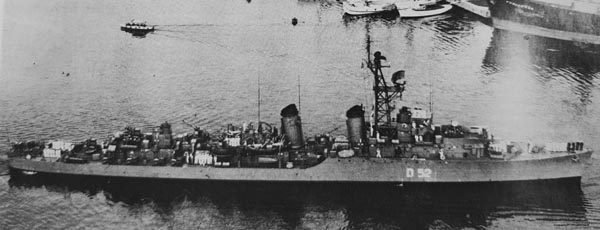
Alava as ASW Frigate
After refit, space was to be found internally and their powerplant was reduced, with an output of 31,500 hp and top speed of 29 knots instead of 36. But they carried now 540 tonnes of oil and had a much better range. The bridge and superstructures were rebuilt, and they were reamed with three 76mm/50 Mk 34, three 40mm/70 SP48 AA, two triple 324 mm ASW TTs, and two 24 tubes Hedgehog Mk 11 ASWRL (178 grenades), eight Depth charges throwers and two racks, about 120 depht charges in store.
The electronics were completely modernized with a new lattice mast to support the radars: MLA-1B and SG-6B radars, Decca TM626 system, two Fire control radars Mk 63 and an American SQS-30A sonar. Alava was stricken in 1978 and Liniers in 1982. Not bad for ships planned in the early 1920s on a WW1 British design.
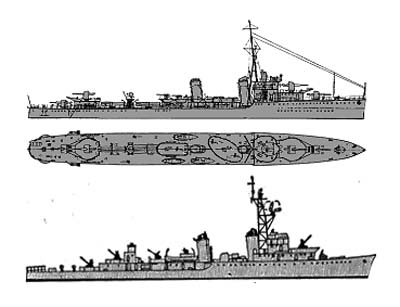
Profile before and after modernization (conways/navypedia)
Specifications (1962)
Displacement: as Group II
Dimensions: as group II
Machinery: 2 shafts Parsons GS turbines, 4 Yarrow boilers, 31,500 shp, 29 knots, range 4500nm/15kts
Armament: 3x 76, 4x 40, 2×3 324 mm ASW TTs, 2 Hedgehog, 8 TDC, 2 DCR
Sensors: Radars SG-6B, LA-1B, Decca TM616, FCS Mk63, sonar SQS-30A.
Crew: 222
 Audaz class (1953)
Audaz class (1953)
Audaz, Osado, Meteoro, Furor, Rayo, Ariete, Temerario, Intrépido, Relámpago (BU 1972-82)
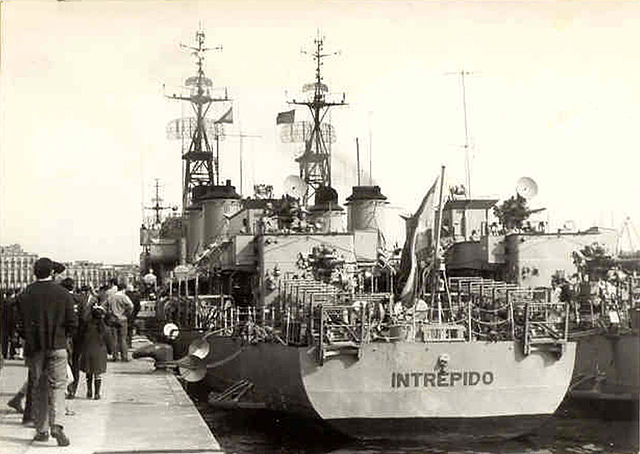
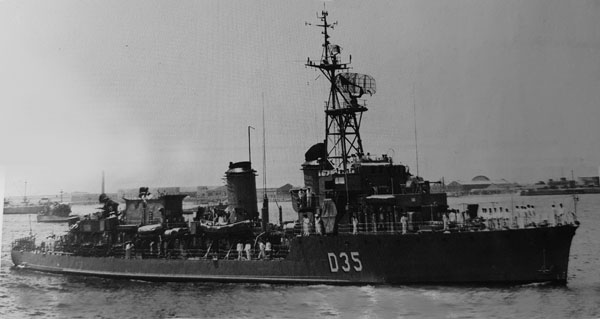
These basically were torpedo boats ordered on 30/3/1944, based on the French Le Fier class, dating back from 1936. Drawings were purchased in occupied France in September 1942. Machinery was licenced from Rateau-Bretagne for the turbines and La Seyne for the boilers, all built in Spain under raised steam parameters, as on Oquendo class destroyers and in échelon machinery with alternated boiler rooms and turbines. The construction also massively used welding.
They would largely differ also by their Spanish armament, their 105 mm aft using DP mountings for AA fire. The first batch were armed with these three 105mm/45 SK C/32, two twin 37mm/83 SK C/30, two quadruple 20mm/65 C/38, two triple 533 mm TT banks, four DCT, one DCR, and 30 mines.
They were ultimately laid down in 1945, and delayed because of financial issues and the situation in France in 1945 for some parts delivery, but also SECN. They boilers appeared absolutely unreliable and had to be fixed, causing more delays. Launched in 1951, they were completed in 1953-56 to the original design for the Audaz, Atrivido, Osado and Rayo, but classified as frigates in 1955. They appeared seriously overloaded and had stability problems. The others stayed in for longer, completely redesigned and emerging in 1960-65. In this new version, they were modernized as AS destroyers, and the early four of the first batc were modernized a little later under the same lines. For this second batch, SNS Rayo was the prototype, in 1958. They had US electronics and armament. Ariete was lost in service in the river Mudros. The others were discarded in 1975, Intrepido in 1982.

Profile of the class in 1960 (Naypedia)
Specifications (1960)
Displacement: 1227 tonnes FL
Dimensions: 93.9 x 9.5 x 3.4 ()
Machinery: 2 shafts SECN Turbines, 3 boilers, 30,800 shp, 31.6-33 knots, range 3800nm/15kts
Armament: 2x76mm/50 Mk 34, 2x40mm/70 SP48, 2×3 324mm ASW TTs, 2 Hedgehog Mk 11 ASWRL, 8 DCT and 2 DCR.
Sensors: SPS-5B, MLA-1B, Mk 63 radars, QHBa sonar
Crew: 199
 Lepanto class (transf. 1957)
Lepanto class (transf. 1957)
Lepanto, Almirante Ferrándiz, Almirante Valdés, Alcalá Galiano, Jorge Juan
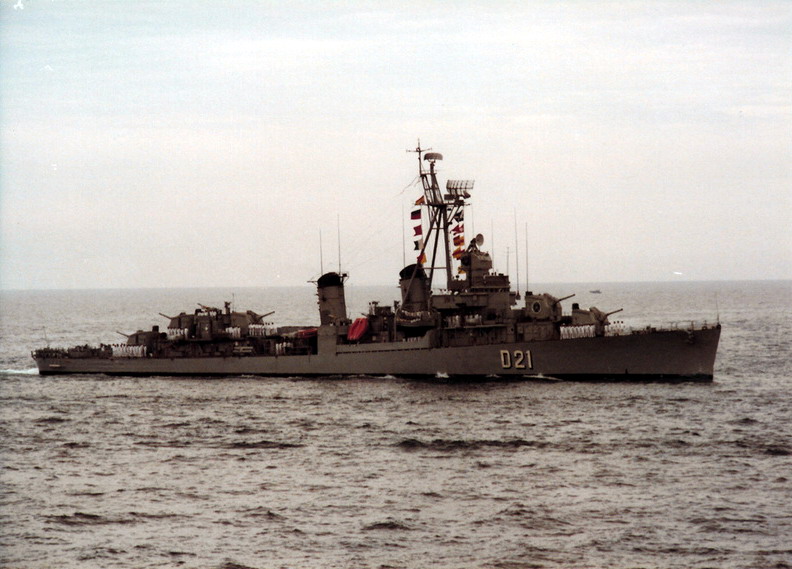
Thes WW2 Fletcher class destroyers were transferred under MDAP from 1957 to 1960 and they were purchased in 1972. They slightly differed in armament, but their modernization consisted in adding ASW torpedo tubes and Hedgehogs and extra AA. They also had a full electronics suite. They were decommissioned in the 1980s, the last, Jorge Juan, in 1988.
Specifications
Armament: 4 or 5 5-in/38, 2 twin 3in/50 mk33 or 6x 40 mm/60, 6x 20mm, 1×3 533 mm TTs or none, 2×3 320 mm ASWRL Mk.32, 2 Hedgehog, 1 DC Rack.
Sensors: Radar SPG-34, SPS-6C, SPS-10 Mk.35, sonar SQS-4 or SQS-29
Crew: 290
 Oquendo class (1963)
Oquendo class (1963)
Oquendo, Roger de Lauria, Marqués de la Ensenada
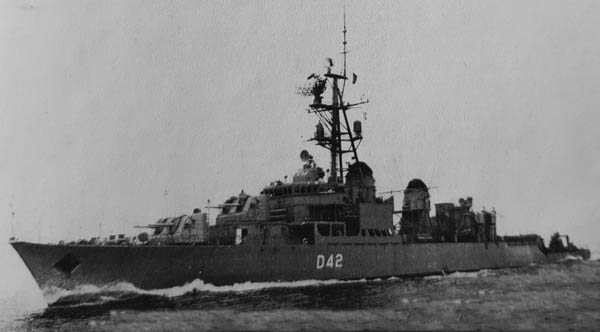
These destroyers were initially planned during WW2, based on the French Le Hardi class for which plans were to be provided, planned FY 1943 at first, and ultimately they were heavily modified as the war ended and were ordered in 1947-48, taking in accounts new design trends. They leaned towards USN destroyers design in particular and were to be provided with US armament and electronics. Construction was eventually limited to three ships, the next batch being of the modified design (De lauria class), whereas the next of the first batch, “Blas de Lezo”, “Gelmírez”, “Lángara”, “Bonifaz”, “Recalde”, and “Blasco de Garay” were cancelled in 1953.
Initial armament as planned were to be four twin 4.1 guns, a triple and two twin 21-in torpedo tubes, and two DCT. See the tables for the changes. Oquendo was launched in 1956 and completed in September 1960, her trials showing massive stability problems. Eventually these led to a complete redesign of the other two, initially completion would occur much later in 1969-70. All three were built in Ferrol. Meawnhile before commissioning, Oquendo was partially rebuilt, bay ballasting the hull and reducing top weight, and further modifications made her join active service in 1963. Her initial displacement was 2050/2765 tonnes, 3.6 m draught, 39 knots, three twin 4.7 in/50 DP, six 40 mm/70 AA, 4x 20mm AA, two Hedgehog, two side launching racks for 320 mm ASW torpedoes (no TTs).
After modifications, see the first table.
The Oquendos were, from the start Spanish designers’s worst nightmare. The process took 15 years after material was procured, and at some point assistance was asked from Ateliers de Bretagne in 1955 to complete the power plant, while the boilers had to be remade and modified several times. With such slow progress, it was decided to radically modified the two other sister-ship as their armaments and electronics did not match the reality of the time. They were from Ferrol to Cartagena, cut in half lengthwise to widen them and reduce the stability issue while new weaponry was to be procured as well as new sensors.
Negociation wit the British failed and then the staff turned to the Americans, ultimately to purchase the entire FRAM II system, ande made the De Lauria a clone of the Gearing FRAM. At the end of the process, on paper the new Roger de Lauria and Marqués de la Ensenada seemed well-equipped for their time, but similar mistakes were yest made as on the Oquendo Audaz-class DDs. The original power plant and machinery was kept and despite their state-of-the-art electronic warfare systems and helicopter facilities, plus a modern and well balanced anti-submarine warfare capabilities, which included a variable depth sonar, their operational value was limited while considerable resources had been allocated on this three-ship class which prevented later improvement.
In the end, the three of the Oquendo class had short careers, of 15, 13, and 18 years respectively with average performance in service. In 1981, as Marqués de la Ensenada was to be decommissioned, she was damaged in Santander by a bomb planted by the ETA at the line of flotation buoys. For political reasons, it was then decided to repair it and maintain the ship until 1988, although it was no longer relevant in a modern warfare environement. She was never upgraded with the proposed SAM or Meroka CIWS and was plagued by boilers problems until the end. They were basically Gearing FRAM with less capabilities whereas the originals had been discarded more ten years ago.

Profile of the Roger de Lauria 1979 (conways)
Specifications (Oquendo, 1963)
Displacement: 2585/3005 tonnes FL
Dimensions: 116.5 x 11.1 x 3.8 (328 x 36 x 11 feets)
Machinery: 2 shafts Rateau GT turbines, 3 3-drum boilers, 60,000 shp, 39 knots, range 5000nm/15kts
Armament: 2×2 4.7in/50 DP, 6x 40mm AA, 2 hedgehog, 2 Torpedo racks.
Sensors: Radar Type 262, 275, 293, SNW-10, sonar QHBa
Crew: 267
Specifications (De lauria)
Displacement: 3012/3785 tonnes FL
Dimensions: 119.3 x 13 x 5.6 (391 x 42 x 18 feets)
Machinery: 2 shafts Rateau GT turbines, 3 3-drum boilers, 60,000 shp, 31 knots, oil 700 tonnes
Armament: 3×2 5-in/38 DP, 2x 21-in TTs, 2×3 12.75 in TTs, 1 helicopter.
Sensors: Radar SPS-10, SPS-37/40, RM-326 FCR Mk.25/28, SQS-28/32C, SQS-10 sonar.
Crew: 318
 Churruca class (Transf. FRAM II 1972)
Churruca class (Transf. FRAM II 1972)
Churruca, Gravina, Méndez Núñez, Lángara, Blas de Lezo
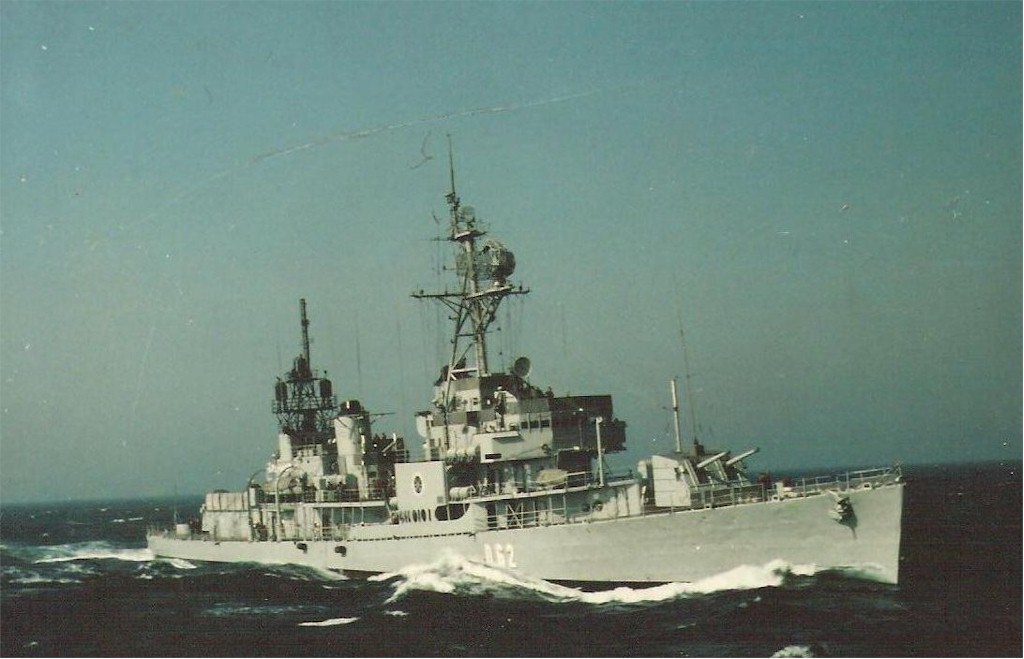
SNS Gravina at sea in the 1980s. credits: 11a Escuadrilla de Escoltas via hazegray (http://www.destructorchurruca.es.vg/)
When transferred in 1972-73, these Gearing class had been modernized to the FRAM I standards. Blas de Lezo kept bth turrets forward and had no ASROC and used the Hugues 500 helicopter, while the otjers had turrets in A and Y positions. No modernization was ever done afterwards, they stayed in their ogiginal configuration until stricken in 1989 (Churruca) and 1991-92 for the others.
Specifications: As FRAM I but:
Armament: 2×2 5-in/38, ASROC, 2×3 12.75 in TTs, 1helicopter.
Sensors: Radar SPS-10, SPS-37/40, FCR Mk.25/28, SQS-28 sonar.
Crew: 274
 Baleares class Frigates (1970)
Baleares class Frigates (1970)
Baleares, Cataluna, Andalucia, Asturias, Extremadura
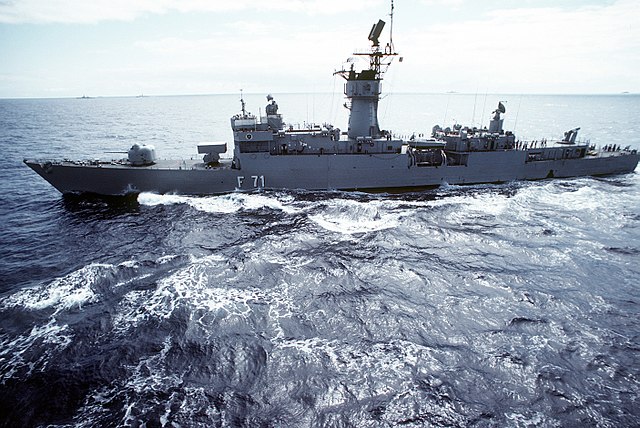
The Baleares were the largest cold war warships built in Spain when they were laid in Ferrol in 1968, and each year, in 1969, 70, 71 and 72 (two), completed 1973-76. They were superficially clones of the Know clas USN Frigates but in reality were tailored for the Armada and were quite different, in many ways, starting from the absence of raised bulwarks and spray strakes, the “hurrican bow” to more clement waters. Also, the aft section was completely modified, as there was no helicopter onboard, so the quarterdeck instead received the SM-1 standard launcher (Tartar at first). The armament was quite different also, apart the main gun. Instead the Know were given a lighter armament, in addition of the ASROC, the standard SM-1, Harpoon antiship missiles from 1983-91 refit, and more diversified torpedo tubes, of 12.75 inches (323 mm) on the sides angled at 45° and 21-inches (533 mm) in the stern, all fitted internally, plus a more extensive electronics suite. These ships looked liked equivalent to destroyers in firepower whereas the original Knox were pure ASW warfare vessels. The Meroka/CIWS were also aded during the 1990s refit. The Meroka were associated with the RAN 12L FCR.
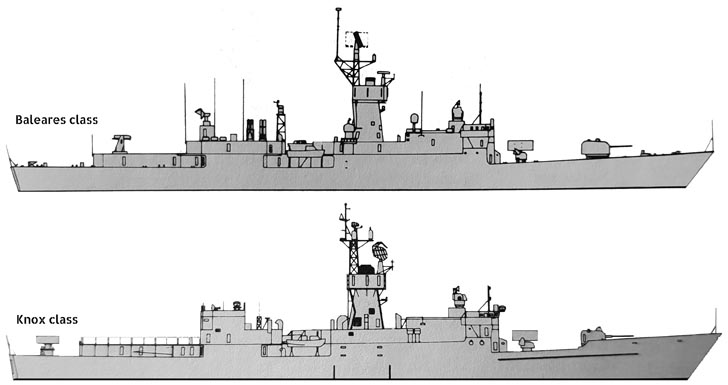
Comparison between the Knox class (below) and Baleares class (top).
Specifications
Displacement: 3015/4177 tonnes FL
Dimensions: 133.5 x 14.25 x 7.5 (438 x 47 x 24 feets)
Machinery: 1 shafts 2 Westing. Gas turbines, 2 V2M boilers, 35,000 shp, 28 knots, range 4500nm/20kts
Armament: 1x 127mm (5in/54) Mk.42, Standard SAM (16 SM1-MR), 8 Harpoon, 2×20 mm CIWS meroka, ASROC, 4x 12.75 in ASW TTs, 2x 21-in TTs.
Sensors: Radar SPS-10, SPS-52A, SPG-51C, SPG-53B, SQS-56, SQS-32V VDS.
Crew: 256
 Santa Maria class Frigates (1984)
Santa Maria class Frigates (1984)
Santa Maria, Victoria, Numancia, Reina Sofia, Navarra, Canarias
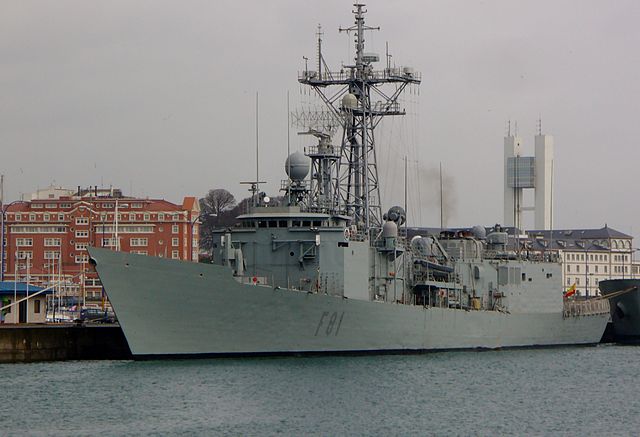
The Santa María class were six locally built vessels based on the Oliver Hazard Perry-class frigates, in two batches with the second comprising F-85 and 86 received an improved combat-data system and updated SPS-49 and SQR-19 radars and sonars, plus the semi-local Meroka CIWS and Mk92 Mod 6 COR and upgraded electronic warfare suite. The Spanish version of the FG-07 had a slightly broader beam, a Meroka CIWS, RAN-12L air search radar, Nettunel EW suite in place of SLQ-32.
In the late 2010s the ships were modernized with a mid-life update (MLU) comprising a new EW suite and improved combat-data system, upgraded Mk92 FCS and new electrical generators and better habitability, at least for the first batch. The second is planned for 2022-2025.
Specifications
Displacement: 4017 tonnes FL
Dimensions: 137.3 x 14.3 x 7.5 (451 x 46 x 24 feets)
Machinery: 1 shafts 2 LM 500 Gas turbines, 40,000 shp, 29 knots, range 4500nm/20kts
Armament: 76 mm (3-in) OTO Melara, Standard SAM (32 +8 harpoon), 1×20 mm CIWS meroka, 2×3 324 mm ASW TTs, 2 LAMPS helicopters.
Sensors: Radar SPN-49, Mk.92 FCS, SQS-56, SQR-19.
Crew: 223
 Artevida class Corvettes (1952)
Artevida class Corvettes (1952)
Atrevida, Descubierta, Diana, Nautilus, Princesa, Villa de Bilbao
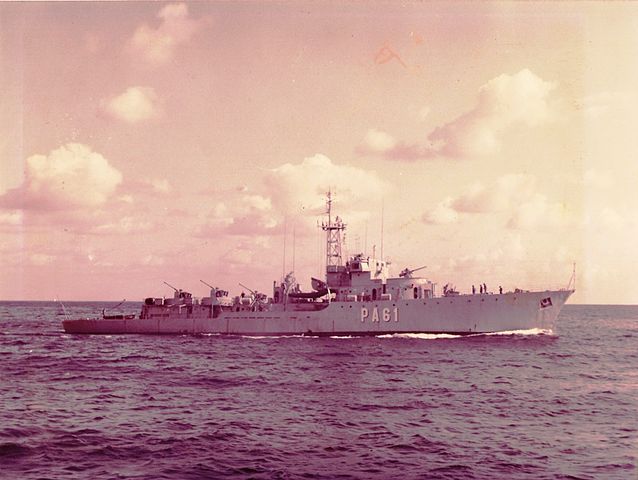
Small ASW corvettes designed in the late 1940s without clear references, they were one-of-a kind, genuinly Spanish. Atrevida and Decubierta, the first two, were armed as in the tables, but the four otjers were modernized in 1959-60 and displacement was now 997 tonnes standard, 1135 FL, 9 feets or 2.7 m draught, one 3in/50 DP gun, 3x 40mm/70 AA, 2 Hedhehogs and 8 DC mortars plus two racks. They were rated as corvettes but given the prefic F, so some had them registers in frigates, but they were way too small for that. Decribierta and Diana were discarded in 1978 and 1973, the others refitted in 1978 for patrol and fihery protection with the following data:
1031 standard/1118 FL tonnes, 9ft 10in draught (3 m), one 3-in/50 DP, 3x40mm/70 AA, 2×20 mm AA. They were ultimately discarded in 1991-92.

Profile of the Atrevida class
Specifications (1954)
Displacement: 912/1022 tonnes FL
Dimensions: 75.5 x 10.2 x 2.6 (247 x 33 x 8 feets)
Machinery: 2 shafts Sulzer diesels 3000 bhp, 18.5 knots, oil 100 tons, range 8000nm/10kts
Armament: one 4.1-in DP, twin 37 mm, 3×4 20mm AA, 4 DCT, 20 mines
Sensors: Radar SPS-5B, Sonar QHBa
Crew: 132
 Descubierta class Corvettes (1975)
Descubierta class Corvettes (1975)
Descubierta, Diana, Infanta Elena, Infanta Cristina, Cazadora, Vencedora
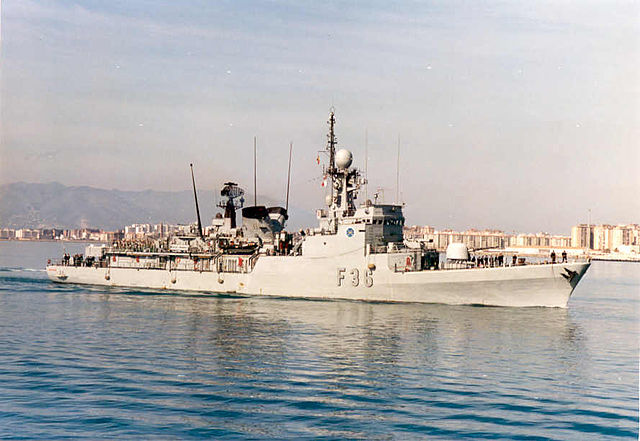
Vencedora F36
Thes ships were developed to replace in the 1980s the Atrevida class. They were larger and better equipped, wth a modern ASW suite, and a composite of technologie from every country. It was truly a “European warship” at a time these collaborations were not yet the norm, but with projects such as the Tornado. The design was prepared by Blohm and Voss shipyards in Germany. They took as model the Joao da Coutinho they developed for portugal, modified by the Bazan yard in Spain before construction, at Ferrol and Cartagena.
In the end, they were ordered in December 1973, with other batches in May 1976 wheras F37 and F38 were sold to Egypt before completion and another built for Morroco. Laid down in 1974-78, they were launched in 1975-79 and completed between 1978 and 1982. The armament was Italian, Swedish and American, electronics were Dutch. They were all in service well past the cold war, and are still in service today.
In the early 1980s was planned a replacement, an improved version of the latter. Several designs were proposed, with a base of 1879 tonnes in displacement, a lenght of approximatively 100m overall, same armament but a hangar and helicopter and gas turbine propulsion for 30+ knots. It was proposed but ultimately declined for the larger FFG-7 model instead.
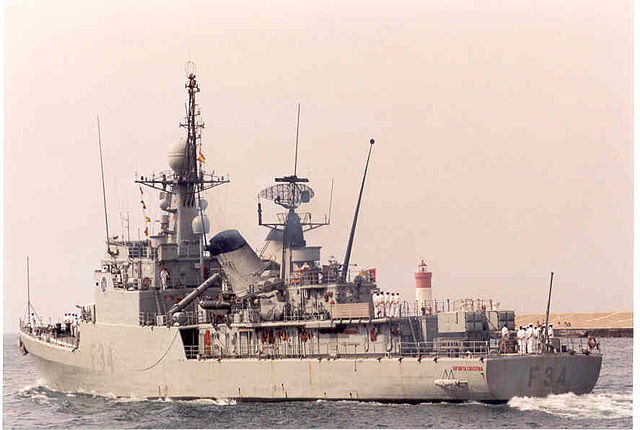
Infanta Cristina F34

Profile in 1978 (conways)
Specifications
Displacement: 1233 standard, 1482 tonnes FL
Dimensions: 88.8 x 10.4 x 3.8 (291 x 34 x 12 feets)
Machinery: 2 shafts MTU-Bazan 16V956 diesels, 16,000 shp, 25 knots, range 4000nm/18kts
Armament: 1x 3in/62 OTO Melara (76mm), 2×40/70 mm Bofors, 8 Harpoon SSM, 1 sea sparrow SAM (8), 1×2 375 mm ASW TT, 2×3 320 mm ASW TTs.
Sensors: Radar DA-05/2, ZW-22/41 or WM-25, sonar DE-1160B
Crew: 118
 Serviola class Corvettes (1990)
Serviola class Corvettes (1990)
Atalaya, Centinela, Serviola, Vigia
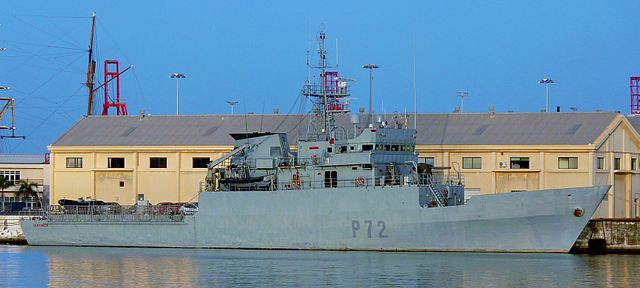
These small corvettes were proposals derived from the 1988 Milano class Type 215, later called the Halcon class. They were larger, faster but lightly armed as previously planned. The initial design was 1360 tonnes FL, 65.3 x 10.1 x 3.2m, 20 knots, 40 mm/70 AA, 2 MGs, 1 Hughues 500 helicopter. The new specs are in the table below. They are present in this page as laid down in 1989 (Serviola) and planned way before in the 1980s to replace the Atrevida class. Launched 190-91 and completed 1991-92 they are still in service today, used as versatile patrol ships, EEZ control ships, and fishery protection vessels with their gun-only capabilities.
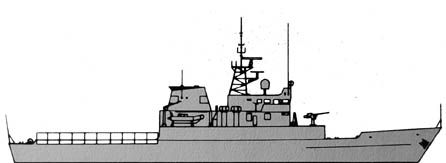
Specifications
Displacement: 836/1106 tonnes FL
Dimensions: 68.7 x 10.4 x 3.4 (225 x 34 x 11 feets)
Machinery: 2 shafts MTU Bazan 13V956 YB91 diesels, 7500 bhp, 19 knots, range 800nm/12kts
Armament: 1×3-in Mk26, 2 MG, 1 helicopter
Sensors: Decca 2459
Crew: 42
 G class submarines (cancelled)
G class submarines (cancelled)
This was the story U-573, a Type VII U-Boat which was in operation in Spanish waters on 1 January 1942, taking refuge after being hunted down by a Sunderland and badly damaged, in Cartagena. She later sold to the Spanish Navy as G-7, entering service in 147 after endless repairs and tests. The 1943 the Spanish naval Programme included six submarines and in 1945 a first batch of four, heavily based on the G7 were ordered, called G1-G4. They were to be based on the Type VII, but plans were ultimaterly abandoned as in the 1950s more modern MDAP provided recent models were to be provided instead.
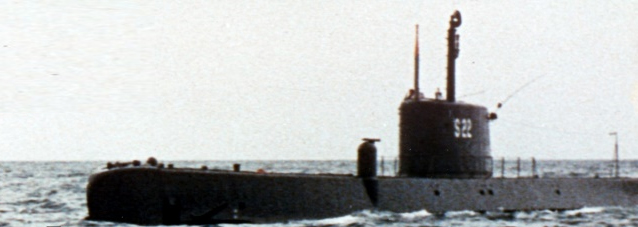
An honorable mention must go also to the D-class, started in 1934 but delayed at first by the civil war and next by WW2. D1, D2, D3 mixed British design and German equipments, but completion had to wait until 1947 for D1, while D2 and D3 were completed after many modifications as defects were discovered in service, in 1954, so twenty years after they were laid down… Modernization attempts concerned S21 and 22, streamlined S-22 in the 1960s with a new conning tower, modern sonar, radar and sensors. Both were discarded in 1971, later than the training submarine S-11 (former D-1), in 1965. They will be covered more in detail if more is discovered on them later. See also Spanish ww2 submarines.
 Spanish Midget submarines (1957)
Spanish Midget submarines (1957)
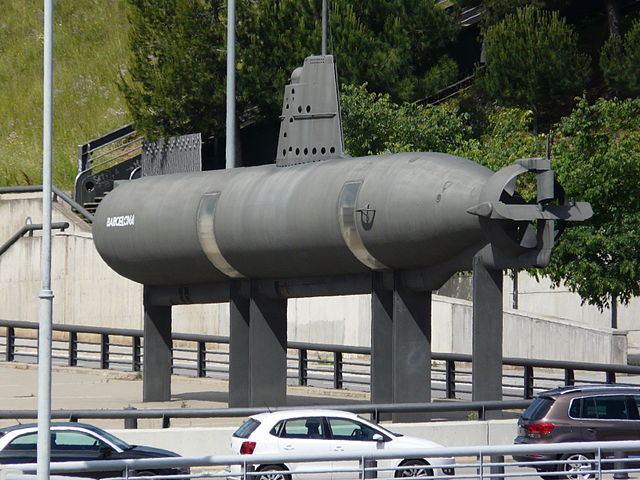
Foca (S40) class Midget Submarine comprised Foca (SA 41/42) and Tiburon (SA 51/52) were two very different midget submarines, semi-experimental as they were only two of each class. A radical departure over the 930 tonnes (submerged) planned G class, derived from the Type VII, they were experiments. The first serie called Foca I and II (or SA 41 class) displaced 16 tonnes to 20 tonnes submerged, for a hull 13.9 m long, 1.8 m wide and 1.5 m tall. They were propelled by a Pegaso diesel 160 bhp coupled with Siemens electric engines for 110 bhp, and were capable of 9.2/12 knots, armed with two 21-in Torpedoes and having a crew of three. They inspired by the German Seehund class, also for special operations, and were re-rated as assault subs in 1963. Probably discarded in 1971, little info available.
The Tiburon I and II were another pair of prototypes, much larger, faster and powerful with a crew of 5, launched in 1958 in Cartagena. They were re-rated as assault subs in 1965, pennants SA 51 and 52. 78 tonnes/81 tonnes sub., 21.5 x 2.7 x 2.7 m, one shaft with two Pegaso diesels for 4000 bhp and electric motors producting in all 400 shp, for 10/14.5 knots. Both were discarded in 1977.
 SNS Almirante Garcia de los Reyes (1959)
SNS Almirante Garcia de los Reyes (1959)

A single ex-Balao class sub, built 1944 and transferred in 1959 after modernization. She was modernized again in 1964-65n with six main TTs but four of 324 mm firing ASW acoustic torpedoes. She was semi-active between 1975 and 1982, used for spare parts for the Peral’s machinery.
Peral class Submarines (1971)
In 1971-74, four more submarines of the Balao class, modernized as GUPPY II, were transferred to Spain under MDAP. Pennants were S32-34. S33 Monturiol was laid up for mechanical problems in 1975 and discarded in 1977, the name given to S35 transferred in 1974. So in all Spain operated four GUPPIes in the 1980s. They were discarded in 1982-84. Specs as GUPPY IIA.
 Delfin class Submarines (1973)
Delfin class Submarines (1973)
Delfin, Tonina, Marsopa, Narval

First modern Spanish submarines built locally, in Cartagena. They were basically French Daphne types, built under licence and with French assistance. Two were ordered in 1966 under a contract agreement and two in March 1970, completed 1973, 75 and 1983 for Delfin (S 61). Pennants S61-64. They were modernized in 1983-1988 with a new sonar and larger dome, and updated FCS. Thanks to this, they stayed in service until the end of the cold war, decommissioned in 2003. S61 became a museum ship at Torrevieja.
Specifications
Displacement: 869/1069 tonnes surf/subm.
Dimensions: 57.8 x 6.8 x 4.6 ( feets)
Machinery: 2 shafts SEMT Pielstick diesels/electric, 1300/1600 shp, 13.2/15.5 knots, range 4300nm/7.5kts
Armament: 8 bo, 4 stern 533 mm (21-in) TTs
Sensors: DUUA 2A (original DUUA 1), DSUV 22.
Crew: 47
 Mistral class Submarines (1981)
Mistral class Submarines (1981)
Galerna, Mistral, Siroco, Tramontana
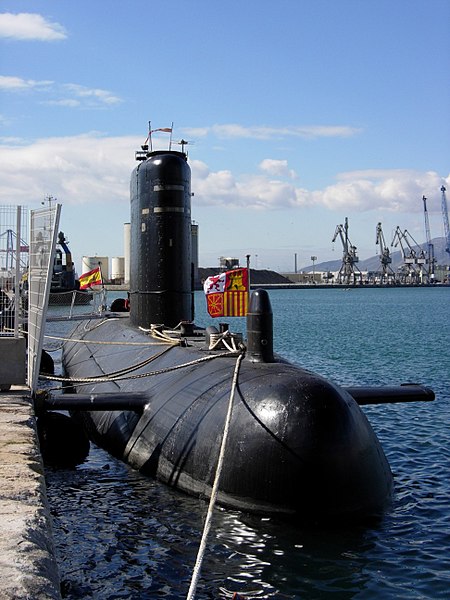
Tramontana S 74
Ordered in 1975 and 1977 in Cartagena (pennants S 71-74), these four boats were based on the French Agosta class, built under contract with French assistance. They were modernized in the mid-1990s with a towed array Sonar, improved fire control and ECM, new batteries and periscopes. The second class S 80 was a common design by Bazan and Dubigeon (later DCN), ready in 1986 but decision was postponed as it was thought better to used the Scorpene design by DCN instead, postponed in 1999, and modified to the S-80 plus standard, made by Navantia in 2007–2021. They were given French torpedoes L5, F17 et E18 and the Exocet SM39. Modenrized in the early 2000s, one had been retired in 2012, Siroco and one in 2020, Mistral but Galerna (S 71) as well as Tramontana (S 74) are still in service, pending replacement by S-80 class boats.
Specifications
Displacement: 1500/1760 tonnes surf/subm.
Dimensions: 67 x 6 x 6 m (219 x 19 feets)
Machinery: 2 SEMT Pielstick 16 PA 4 960 kW +3 500 kW schneider electric engine, 12,5/20 kts, 300m depth
Armament: 4 bow tubes, 533 mm (21-in) TTs for Torpedes or Missiles
Sensors: Bow DUUA2 + towed ETBF DSUV62 sonars.
Crew: 54
Spanish Amphibious ships
 Galicia LSD (1971)
Galicia LSD (1971)
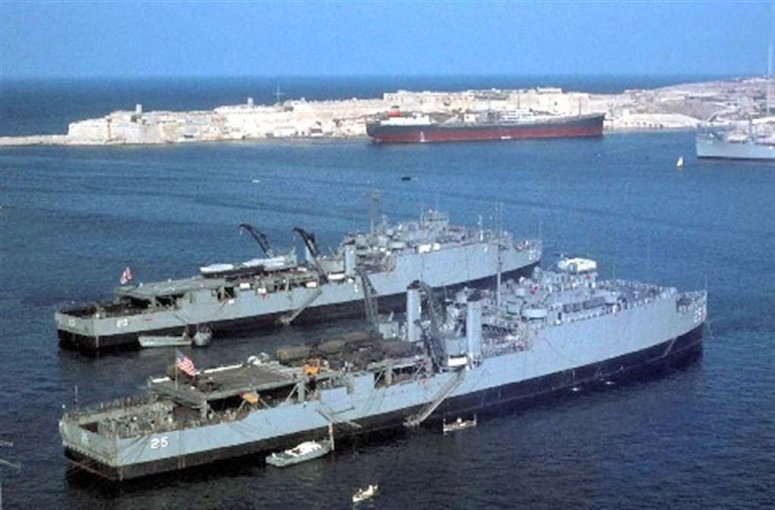
USS San Marcos and Donner
A single Landing Ship, Dock (LSD) of the L-30 Casa Grande-class was transferred in 1971. She was the ex LSD25 San Marcos (1945), renamed L-31 Galicia and in service from 1971 to 1988, replaced by the new Carlos I of the LHD type. Specs as the same as the original US WW2 Casa Grande-class.
 Velasco class TLS (1971)
Velasco class TLS (1971)
Velasco, Martín Álvarez, Conde de Venadito

USS Wexford County, sold as Martín Álvarez
In 1971, three L-10 Terrebone Parish-class tank landing ship (LST) were transferred to Spain. These were LST1156 Terrebonne Parish (1952), LST1168 Wexford County (1954) and LST1159 Tom Green County (1953), all three dioscarded in 1971 as surplus and renamed after transfer as L-11 Velasco (1971–1994), L-12 Martín Álvarez (1971–1995) and L-13 Conde de Venadito (1972–1990). Specifications as for the US Terrebone Parrish class (to be seen in the cold war US amphibious fleet). Note that also transferred Paul Revere class ships, L-21 Castilla (1980–1998), ex-LPA248 Paul Revere 1958–1980 and L-22 Aragón (1980–2000) (ex-LPA249 Francis Marion 1958–1980).
 Aragon Attack Transport (1964)
Aragon Attack Transport (1964)

As USS Noble, off California 1956
The TA-10 Haskell-class attack transport (APA) served as APA218 USS Noble from 1944 to 1964, transferred to the Armada as TA-11 Aragon and in service until 1982. Specifications as for the Haskell class.
 Castilla Attack Cargo Ship (1965)
Castilla Attack Cargo Ship (1965)

As USS Archernar
This was a TA-20 Andromeda-class attack cargo ship (AKA) which first served as AKA53 USS Achernar from 1944 to 1963 and was stranferred to Spain as TA-21 Castilla, discarded in 1982.
Specifications as like the Andromeda class – USS Amphibious ships.
 Cortes class tank landing ship (1995)
Cortes class tank landing ship (1995)
Hernán Cortes
Although out of the current frame of the cold war, by just a mere two years, were the two Newport class vessels, Tank, Landing Ship of the cold war. These were the USS LST-1197 Barnstable County (1971), discarded 1994, transferred as L-41 Hernán Cortes in 1995 and in service until 2009 and USS Harlan County (1971–1995), which became L-42 Pizarro in 1995, retired in 2012. Specs as usual, as the original class.
 Spanish Landings Crafts (1960-83)
Spanish Landings Crafts (1960-83)
Spain operated 26 old X-Type lighters (Built in UK and transferred postwar), K-1 to K-26 (1924) for some in service until 1962. They were ex British X4, X6, X13, X14, X16, X17, X26, X50, X63, X74, X91, X108, X109, X129, X141, X148, X153, X170, X172, X173, X174, X186, X190, X 200, X205 and X221.
Also were concerned the fromer British LCTs called the Tipo BDK class:
BDK-1 renamed LCT-1. Ex-HMS LCT(4) 1253, ex- Foca (1948–1978)
BDK-2 renamed LCT-2. Ex-HMS LCT(4) 1323, ex- Morsa (1948–1983)
BDK-3 renamed LCT-3. (1957-)
BDK-4 renamed LCT-4. (1957-)
BDK-5 renamed LCT-5. (1957-)
BDK-6 renamed LCT-6. (1966–2004)
BDK-7 renamed LCT-7 renamed A-07. (1966–1997)
BDK-8 renamed LCT-8 renamed A-08. (1966–2004)
Also concerned were eighteen LCM3 (acquired 1957) transferred as LCM-1 to LCM-19, not renamed.
And three vessels of the LSM type, US-built and also WW2 stock: LSM-1 (ex-USS LSM-329), LSM-2 ex-USS LSM-331 and LSM-3 ex-USS LSM-343, transferred in 1960 and in service until 1976-77.
Spanish Small Surface Combatants
 LT27 class FAC (Torpedo) (1952)
LT27 class FAC (Torpedo) (1952)
LT-27, LT-28, LT-28, LT-29, LT-30, LT-31, LT-32
Typical Lürrsen 1944 S-Boats types built in 1952-56 at La Carraca Yard, Cadiz, LT27-32 discarded in 1963-78 (No photo).
 Lazaga class FAC (1972)
Lazaga class FAC (1972)
Lazaga, Alsedo, Cadarso, Villamil, Bonifaz, Recalde
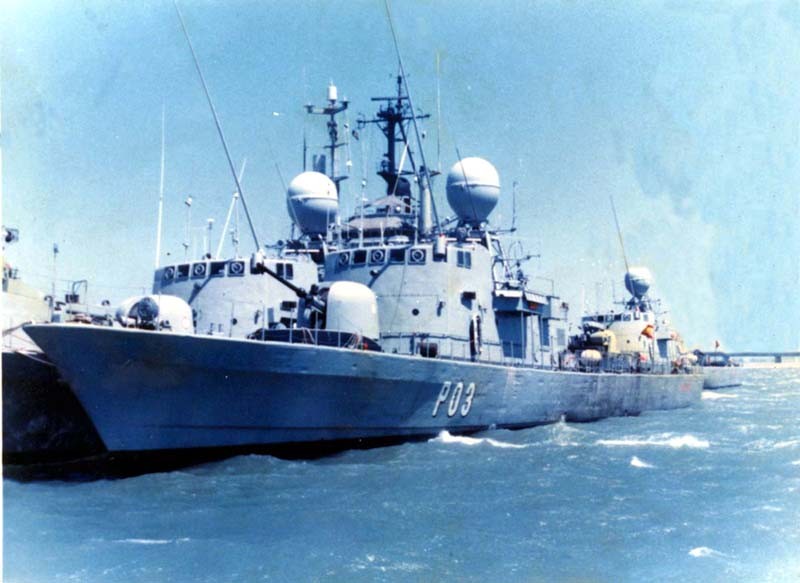
Cadarso (P03) of the Lürrsen licence-built Lazaga class FAC
Spain ordered to the same company (Lürrsen) in 1972 new replacement vessels based on tye T42 design, without changes. The very first was built in Vegesack and the follow-up in Bazan in 1974-77. They were used for fishery protection duties in peacetime, later relieved by the Anaga class. They had a planned Harpoon SSM upgrade which was never done and ASW weapons were not present on all ships. They were all discarded in 1993.
Specifications
Displacement: 275 t. standard, 399 t FL
Dimensions: 54.4/58.1 x 7.6 x 2.8 m (190 x 24 x 9 feets)
Machinery: 2 MTU Bazan diesels MA15 TB91 8,000 bhp 30 kts
Range: 2260/4200 nm at 27/17 kts
Armament: 1x 76 mm OTO, 1x 40mm Breda, 2x 20mm Oerlikon GK204, 2×3 Mk32 TTs, DCR
Sensors: WM 22 radra, sonar ELAC.
Crew: 34
 Barcelo class FAC (1975)
Barcelo class FAC (1975)
Barcelo, Laya, Javier Quiroga, Ordonez, Acevedo, Candido Perez
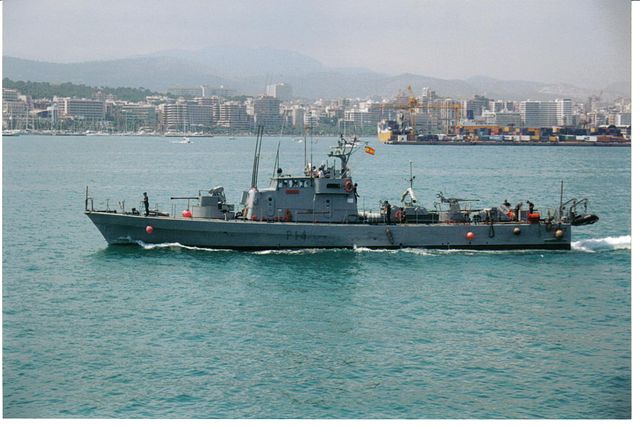
Ordonez (P14) of the Barcelo class
6 ships (PC-11 to PC-16), ordered in 1973 on a modified, much smaller Lürssen design, the first again built in vegesack and the others in Bazan, La Carraca in 1975-77 and used also for fihsery protection. In peactime, their two single 21-in TTs were not fixed, but stored in a depot. They were discarded in the late 1990s.
Specifications
Displacement: 134 t. standard, ? t FL
Dimensions: 36.2 x 5.8 x 2.5 m (119 x 19 x 8 feets)
Machinery: 2 MTU Bazan diesels MD16V TB90 5,760 bhp 36 kts
Range: 600/1200 nm at 33.5/16 kts
Armament: 1x 40mm Breda, 2x 20mm Oerlikon GAM204, 2×12.7 mm HMGs TTs, see notes
Sensors: Raytheon 1620/6 radar.
Crew: 40
 Cormoran FAC (1985)
Cormoran FAC (1985)
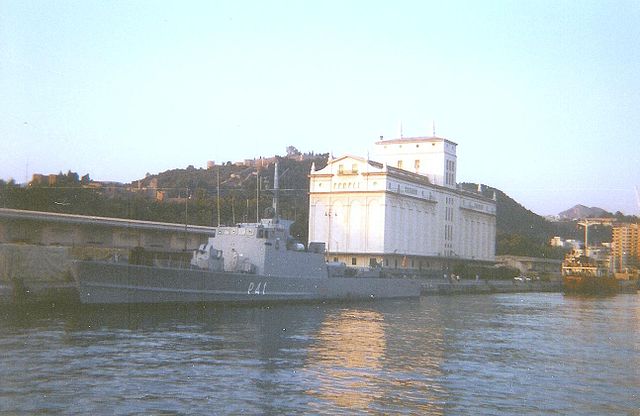
Cormoran (P41)
A singular, unique vessel, buit at Bazan, Ferrol in 1985 as a private venture. The Spanish Navy however purchased and commissioned her as a test ship. In between she was used as an OPV. There was an option to return her to the built if the latter found another buyer. In fact the company used her as demonstrator and the same model was purchased by Morocco and the Philippines.
Specifications
Displacement: 374 t. FL
Dimensions: 56.6 x 7.5 x 2.8 m (186 x 25 x 6 feets)
Machinery: 3 MTU Bazan diesels MA16V TB91 13,500 bhp 34 kts
Armament: 1x 40mm Breda, 1x 20mm Oerlikon GK204
Sensors: Unknown, likely Raytheon 1620/6 surface search and navigation radar.
Crew: 30 est.
Patrol Crafts
 Patrol Boat Javier Quiroga (1956)
Patrol Boat Javier Quiroga (1956)
Javier Quiroga was a lone patrol vessel, ex PC type built in 1943 and transferred in 1956 to Spain, rearmed with two 37 mm Breda AA guns in 1956. Stricken 1971.
 Anaga class Patrol Crafts (1979)
Anaga class Patrol Crafts (1979)
Anaga, Togomago, Marola, Monro, Grosa, Medas, Izaro, Tabarca, Deva, Bergantin
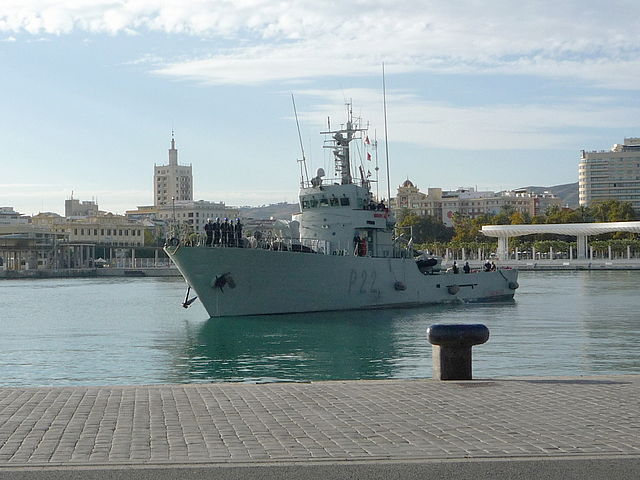
Tagomago of the Anagla class PBs (1980)
Ten vessels (PVZ-21 to 29 and 210) ordered from Bazan, Ferrol, in 1978. They were completed 1980-82 and designed for fishery protection duties on the Spanish EEZ in replacement to the Lazaga class. Discarded in the 2000s.
Specifications
Displacement: 296.5 t. FL
Dimensions: 44.4 x 6.6 x 2.5 m (146 x 22 x 8 feets)
Machinery: 1 shaft MTU Bazan diesel 4,300 bhp, 22 kts
Range: 4,000 nm at 15 kts
Armament: 1x 76mm OTO melara Compact, 2x Mk100 AA guns.
Sensors: Navigational radar.
Crew: 25
 Naron class Patrol Crafts (1980)
Naron class Patrol Crafts (1980)
Naron, Turia, Ulla, Mino, Sil
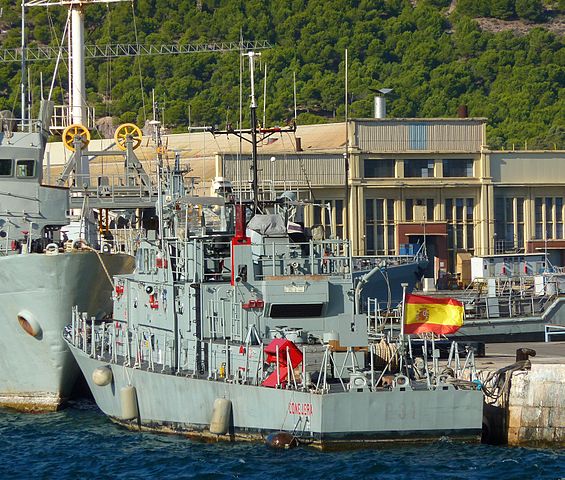
Conejera (1982)
Former US AMS minesweepers, transferred in 1980 as large patrol crafts, stricken 1993. The last two were reconverted as minesweepers in 1984. Now all stricken.
 P50 class Patrol Crafts (1990)
P50 class Patrol Crafts (1990)
P50, 51, 52, 53, 54, 55
Six OPVs, scheduled for order in 1990 but postponed and finally cancelled. They were interesting large vessels to protect Spanish EEZ, with a helipad and telescopic hangar for an Agusta-Bell AB212.
Specifications
Displacement: ? t. standard, ? t FL
Dimensions: 55.6 x 11 x 3? m (182 x 36 ft)
Machinery: 2 Deutz SBV-8M diesels 4,450 bhp 16 kts
Range: 7,500 nm at 12 kts
Armament: 1x 40mm Breda, 2x 20mm Oerlikon GAM204, 1 helicopter
Sensors: Surface search and navigational radars.
Crew: 34
 Spanish Light Patrol Crafts
Spanish Light Patrol Crafts
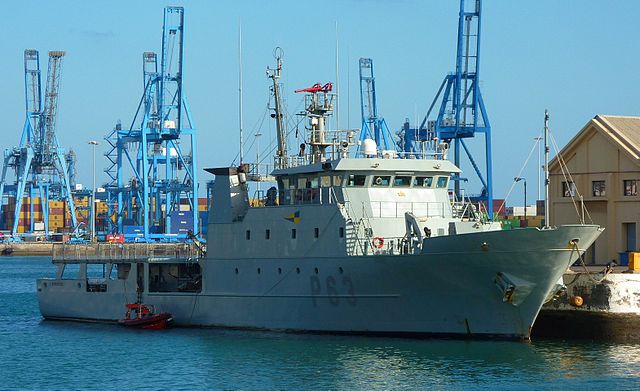
Patrol ship SNS Arnomendi Chilreu
Pegaso class (1947): Two vessels built in Cartagena 1947-1951. Coast guard vessels attached to the naval school and used as TS until 1970; 503 t FL, 1x 3 in and 2x 20 mm AA, 12 kts. These were the only ships of the 12-strong vessels planned in 1945 (Rigel class).
Centinella class (1953): Centinela and Serviola were complete at Ferrol, and rated as fishery protection vessels, then sold to Mauretania in 1977. 28t, 2x 37mm, 12 kts.
Cies class (1952): Cies and Salvora were purchased in 1952, used as fishery protecton vessels (FPV) until 1973 and 1990. Trawler type, 270t, 12 kts, 1x 20mm.
Candido Perez (1956): W11, ex SC-679, former US sub-chaser of the SC type, 110 feet type in 1956, stricken 1974.
Chilreu (1995): Launched 1988, purchased as FPV, trawler type, still in service. 1157t FL, 1MG, 13 kts.
P31 class (1995): Also named as the Conejara class. Ten inshore CPVs, motor launches built 1981-82, in service until the 2000s.
Mine warfare vessels
 Bidasoa class (1943)
Bidasoa class (1943)
Bidasoa, Guadalete, Lerez, Nervion, Segura, Tambre, Ter (M01-06)
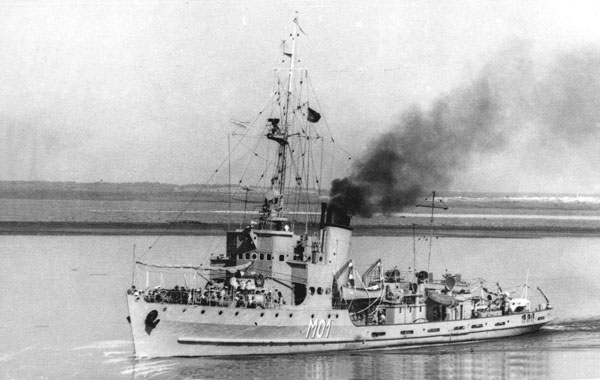
M class (Bidasoa). technically seen in the WWII section as they were built on the M1940 Type German minesweepers, started in 1942 but not completed before 1946-47. Stricken 1971-72 apart Guadalete, foundered 1954.
 Guadiaro class minesweepers (1950)
Guadiaro class minesweepers (1950)
Almanzora, Eo, Eume, Guadalhorce, Guadiaro, Navia, Tinto (M11-17).
The were German-designed 1940 type minesweepers, built in spain and launched 1950-53, retired 1971-73. Very similar to the Bidasoa class but with an auxiliary turbine using the exhaust steam from the reciprotacing engine. They were entirely modernized in 1959-61, with the removal of the 3.5 in gun and 37 mm AA guns and used as CPVs until discarded in 1976-79.
Specifications
Displacement: 670 t. standard, 770 t FL
Dimensions: 74.3 x 10.2 x 3.7 m (243 x 33 x 12 feets)
Machinery: 2 shafts VTE + aux. turbine, 2 yarrow boilers, 2400 ihp, 16 kts
Range: 1000 nm at 16 kts
Armament: 1x 3.5 mm Hontoria, 1x 37mm AA, 2×20 mm Oerlikon.
Sensors: TM-626/RM 914, Sonar UQS-1 radar.
Crew: 79
 Duero class minesweepers (1954)
Duero class minesweepers (1954)
Duero, Ebro, Genil, Jucar, Llobregat, Nalon, Odiel, Sil, Tajo, Turia, Ulla.
These were wooden hulled minesweepers of the WW2 Adjutant/Redwing/MSC class launched 1953-58, transferred 1954-59 as part of the MDAP programme. Llobregat was discarded in 1980 after a fire while five others were used as OPVs with PVZ numbers (and three later back as minesweepers). The others were modernized with Decca radar and sonar, in the late 1980s and still active in the late 1990s.
 Guadalete class minesweepers (1971)
Guadalete class minesweepers (1971)
Guadalete, Guadalmedina, Guadalquivir, Guadiana
Five ex-US Agressive class ocean minesweepers, built 1952-55 and transferred under MDAP in 1971. They were purchased in 1974, with a SQQ-14 VDS for mine classification, but wothout PAP or its facilities. In 1980 Guadalete became OPV with PVZ number, but was reverted to minesweeper before the 1990s. All were discarded in the late 1990s.
 CME class minehunter (1995)
CME class minehunter (1995)
Te replace the old vessels above, Spain considered several designs to be built locally in Ferrol. 12 vessels were considered, either of teh Tripartite or Lerici classes, modern minehunters, pitted against the US MHC design and a local design called “Cazador”. Eventually a contratct was signed in July 1989 with Vosper Thornycroft for Bazan to built a Sandown class derivative under licence with the SRMH GRP materials technology transfer (and later DCN). Eight hunters, four Sweepers. Eventually, order came in 1993, after the cold war, so it goes beyond the present chapter.


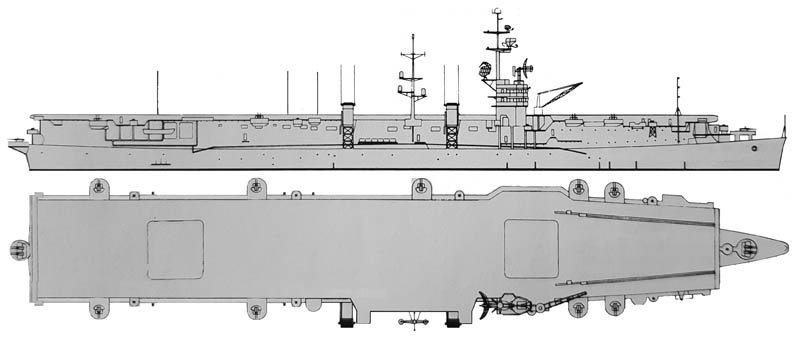
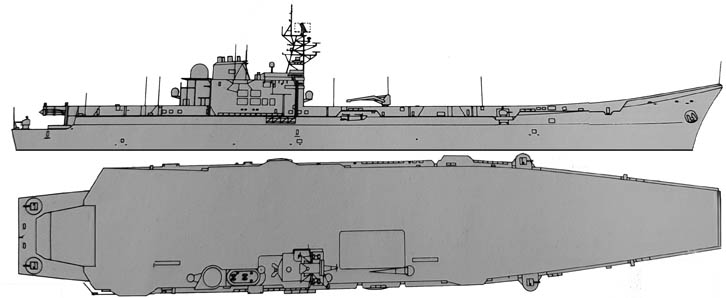
 Latest Facebook Entry -
Latest Facebook Entry -  X(Tweeter) Naval Encyclopedia's deck archive
X(Tweeter) Naval Encyclopedia's deck archive Instagram (@navalencyc)
Instagram (@navalencyc)





 French Navy
French Navy Royal Navy
Royal Navy Russian Navy
Russian Navy Armada Espanola
Armada Espanola Austrian Navy
Austrian Navy K.u.K. Kriegsmarine
K.u.K. Kriegsmarine Dansk Marine
Dansk Marine Nautiko Hellenon
Nautiko Hellenon Koninklije Marine 1870
Koninklije Marine 1870 Marinha do Brasil
Marinha do Brasil Osmanlı Donanması
Osmanlı Donanması Marina Do Peru
Marina Do Peru Marinha do Portugal
Marinha do Portugal Regia Marina 1870
Regia Marina 1870 Nihhon Kaigun 1870
Nihhon Kaigun 1870 Preußische Marine 1870
Preußische Marine 1870 Russkiy Flot 1870
Russkiy Flot 1870 Svenska marinen
Svenska marinen Søværnet
Søværnet Union Navy
Union Navy Confederate Navy
Confederate Navy Armada de Argentina
Armada de Argentina Imperial Chinese Navy
Imperial Chinese Navy Marinha do Portugal
Marinha do Portugal Mexico
Mexico Kaiserliche Marine
Kaiserliche Marine 1898 US Navy
1898 US Navy Sovietskiy Flot
Sovietskiy Flot Royal Canadian Navy
Royal Canadian Navy Royal Australian Navy
Royal Australian Navy RNZN Fleet
RNZN Fleet Chinese Navy 1937
Chinese Navy 1937 Kriegsmarine
Kriegsmarine Chilean Navy
Chilean Navy Danish Navy
Danish Navy Finnish Navy
Finnish Navy Hellenic Navy
Hellenic Navy Polish Navy
Polish Navy Romanian Navy
Romanian Navy Turkish Navy
Turkish Navy Royal Yugoslav Navy
Royal Yugoslav Navy Royal Thai Navy
Royal Thai Navy Minor Navies
Minor Navies Albania
Albania Austria
Austria Belgium
Belgium Columbia
Columbia Costa Rica
Costa Rica Cuba
Cuba Czechoslovakia
Czechoslovakia Dominican Republic
Dominican Republic Haiti
Haiti Hungary
Hungary Honduras
Honduras Estonia
Estonia Iceland
Iceland Eire
Eire Equador
Equador Iran
Iran Iraq
Iraq Latvia
Latvia Liberia
Liberia Lithuania
Lithuania Mandchukuo
Mandchukuo Morocco
Morocco Nicaragua
Nicaragua Persia
Persia San Salvador
San Salvador Sarawak
Sarawak Uruguay
Uruguay Venezuela
Venezuela Zanzibar
Zanzibar Warsaw Pact Navies
Warsaw Pact Navies Bulgaria
Bulgaria Hungary
Hungary

 Bundesmarine
Bundesmarine Dutch Navy
Dutch Navy Hellenic Navy
Hellenic Navy Marina Militare
Marina Militare Yugoslav Navy
Yugoslav Navy Chinese Navy
Chinese Navy Indian Navy
Indian Navy Indonesian Navy
Indonesian Navy JMSDF
JMSDF North Korean Navy
North Korean Navy Pakistani Navy
Pakistani Navy Philippines Navy
Philippines Navy ROKN
ROKN Rep. of Singapore Navy
Rep. of Singapore Navy Taiwanese Navy
Taiwanese Navy IDF Navy
IDF Navy Saudi Navy
Saudi Navy Royal New Zealand Navy
Royal New Zealand Navy Egyptian Navy
Egyptian Navy South African Navy
South African Navy






























 Ukrainian Navy
Ukrainian Navy dbodesign
dbodesign